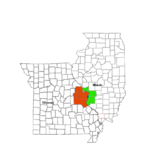St. Louis (/seɪnt ˈluːɪs, sənt-/ saynt LOO-iss, sənt-)[11] is an independent city in the U.S. state of Missouri. It is located near the confluence of the Mississippi and the Missouri rivers. In 2020, the city proper had a population of 301,578,[8] while its bi-state metropolitan area, which extends into Illinois, had an estimated population of over 2.8 million. It is the largest metropolitan area in Missouri and the second largest in Illinois. The city's combined statistical area (CSA) is the 20th largest in the United States.[12]
The land that is now St. Louis had been occupied by Native American cultures for thousands of years before European settlement. The city was founded on February 14, 1764, by French fur traders Gilbert Antoine de St. Maxent, Pierre Laclède and Auguste Chouteau.[13] They named it for king Louis IX of France, and it quickly became the regional center of the French Illinois Country. In 1804, the United States acquired St. Louis as part of the Louisiana Purchase. In the 19th century, St. Louis developed as a major port on the Mississippi River; from 1870 until the 1920 census, it was the fourth-largest city in the country. It separated from St. Louis County in 1877, becoming an independent city and limiting its political boundaries. In 1904, it hosted the Louisiana Purchase Exposition, also known as the St. Louis World's Fair, and the Summer Olympics.[14][15]
Designated as a global city by the Globalization and World Cities Research Network, the GDP of Greater St. Louis was $209.9 billion in 2022.[16][17] St. Louis has a diverse economy with strengths in the service, manufacturing, trade, transportation, and aviation industries.[18] It is home to fifteen Fortune 1000 companies, seven of which are also Fortune 500 companies.[19] Federal agencies headquartered in the city or with significant operations there include the Federal Reserve Bank of St. Louis, the U.S. Department of Agriculture, and the National Geospatial-Intelligence Agency.
Major research universities in Greater St. Louis include Washington University in St. Louis, Saint Louis University, and the University of Missouri–St. Louis. The Washington University Medical Center in the Central West End neighborhood hosts an agglomeration of medical and pharmaceutical institutions, including Barnes-Jewish Hospital.
St. Louis has four professional sports teams: the St. Louis Cardinals of Major League Baseball, the St. Louis Blues of the National Hockey League, St. Louis City SC of Major League Soccer, and the St. Louis BattleHawks of the United Football League. Among the city's notable attractions are the 630-foot (192 m) Gateway Arch in Downtown St. Louis, the St. Louis Zoo, the Missouri Botanical Garden, the St. Louis Art Museum, and Bellefontaine Cemetery and Arboretum.[20][21][22]
History
Mississippian culture and European exploration
Kingdom of France 1690s–1763
Kingdom of Spain 1763–1800
French First Republic 1800–1803
United States 1803–present
The area that would become St. Louis was a center of the Native American Mississippian culture, which built numerous temple and residential earthwork mounds on both sides of the Mississippi River. Their major regional center was at Cahokia Mounds, active from 900 to 1500. Due to numerous major earthworks within St. Louis boundaries, the city was nicknamed as the "Mound City". These mounds were mostly demolished during the city's development. Historic Native American tribes in the area encountered by early Europeans included the Siouan-speaking Osage people, whose territory extended west, and the Illiniwek.
European exploration of the area was first recorded in 1673, when French explorers Louis Jolliet and Jacques Marquette traveled through the Mississippi River valley. Five years later, La Salle claimed the region for France as part of La Louisiane, also known as Louisiana.
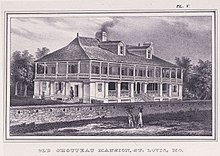
The earliest European settlements in the Illinois Country (also known as Upper Louisiana) were built by the French during the 1690s and early 1700s at Cahokia, Kaskaskia, and Fort de Chartres. Migrants from the French villages on the east side of the Mississippi River, such as Kaskaskia, also founded Ste. Genevieve in the 1730s.
In 1764, after France lost the Seven Years' War, Pierre Laclède and his stepson Auguste Chouteau founded what was to become the city of St. Louis.[23] (French lands east of the Mississippi had been ceded to Great Britain and the lands west of the Mississippi to Spain; Catholic France and Spain were 18th-century allies. Louis XV of France and Charles III of Spain were cousins, both from the House of Bourbon.[24][circular reference]) The French families built the city's economy on the fur trade with the Osage, as well as with more distant tribes along the Missouri River. The Chouteau brothers gained a monopoly from Spain on the fur trade with Santa Fe. French colonists used African slaves as domestic servants and workers in the city.
During the negotiations for the 1763 Treaty of Paris, French negotiators agreed to transfer France's colonial territories west of the Mississippi and Missouri rivers to New Spain to compensate for Spanish territorial losses during the war. These areas remained under Spanish control until 1803, when they were transferred to the French First Republic. During the American Revolutionary War, St. Louis was unsuccessfully attacked by British-allied Native Americans in the 1780 Battle of St. Louis.[25]
City founding
The founding of St. Louis was preceded by a trading business between Gilbert Antoine de St. Maxent and Pierre Laclède (Liguest) in the fall of 1763. St. Maxent invested in a Mississippi River expedition led by Laclède, who searched for a location to base the company's fur trading operations. Though Ste. Genevieve was already established as a trading center, he sought a place less prone to flooding. He found an elevated area overlooking the flood plain of the Mississippi River, not far south from its confluence with the Missouri and Illinois rivers. In addition to having an advantageous natural drainage system, there were nearby forested areas to supply timber and grasslands which could easily be converted for agricultural purposes. This place, declared Laclède, "might become, hereafter, one of the finest cities in America." He dispatched his 14-year-old stepson, Auguste Chouteau, to the site, with the support of 30 settlers in February 1764.[26]
Laclède arrived at the future town site two months later and produced a plan for St. Louis based on the New Orleans street plan. The default block size was 240 by 300 feet, with just three long avenues running parallel to the west bank of the Mississippi. He established a public corridor of 300 feet fronting the river, but later this area was released for private development.[26]
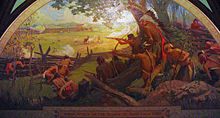
For the first few years of St. Louis's existence, the city was not recognized by any of the governments. Although the settlement was thought to be under the control of the Spanish government, no one asserted any authority over it, and thus St. Louis had no local government. This vacuum led Laclède to assume civil control, and all problems were disposed in public settings, such as communal meetings. In addition, Laclède granted new settlers lots in town and the surrounding countryside. In hindsight, many of these original settlers thought of these first few years as "the golden age of St. Louis".[27] In 1763, the Native Americans in the region around St. Louis began expressing dissatisfaction with the victorious British, objecting to their refusal to continue to the French tradition of supplying gifts to Natives. Odawa chieftain Pontiac began forming a pan-tribal alliance to counter British control over the region, but received little support from the indigenous residents of St. Louis. By 1765, the city began receiving visits from representatives of the British, French, and Spanish governments.
St. Louis was transferred to the French First Republic in 1800 (although all of the colonial lands continued to be administered by Spanish officials), then sold by the French to the U.S. in 1803 as part of the Louisiana Purchase. St. Louis became the capital of, and gateway to, the new territory. Shortly after the official transfer of authority was made, the Lewis and Clark Expedition was commissioned by President Thomas Jefferson. The expedition departed from St. Louis in May 1804 along the Missouri River to explore the vast territory. There were hopes of finding a water route to the Pacific Ocean, but the party had to go overland in the Upper West. They reached the Pacific Ocean via the Columbia River in summer 1805. They returned, reaching St. Louis on September 23, 1806. Both Lewis and Clark lived in St. Louis after the expedition. Many other explorers, settlers, and trappers (such as Ashley's Hundred) would later take a similar route to the West.
19th century
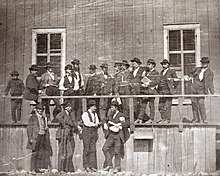
The city elected its first municipal legislators (called trustees) in 1808. Steamboats first arrived in St. Louis in 1817, improving connections with New Orleans and eastern markets. Missouri was admitted as a state in 1821. St. Louis was incorporated as a city in 1822, and continued to develop largely due to its busy port and trade connections.
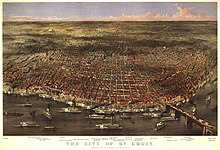

Immigrants from Ireland and Germany arrived in St. Louis in significant numbers starting in the 1840s, and the population of St. Louis grew from less than 20,000 inhabitants in 1840, to 77,860 in 1850, to more than 160,000 by 1860. By the mid-1800s, St. Louis had a greater population than New Orleans.
Settled by many Southerners in a slave state, the city was split in political sympathies and became polarized during the American Civil War. In 1861, 28 civilians were killed in a clash with Union troops. The war hurt St. Louis economically, due to the Union blockade of river traffic to the south on the Mississippi River. The St. Louis Arsenal constructed ironclads for the Union Navy.
Slaves worked in many jobs on the waterfront as well as on the riverboats. Given the city's location close to the free state of Illinois and others, some slaves escaped to freedom. Others, especially women with children, sued in court in freedom suits, and several prominent local attorneys aided slaves in these suits. About half the slaves achieved freedom in hundreds of suits before the American Civil War. The printing press of abolitionist Elijah Parish Lovejoy was destroyed for the third time by townsfolk. He was murdered the next year in nearby Alton, Illinois.
After the war, St. Louis profited via trade with the West, aided by the 1874 completion of the Eads Bridge, named for its design engineer. Industrial developments on both banks of the river were linked by the bridge, the second in the Midwest over the Mississippi River after the Hennepin Avenue Bridge in Minneapolis. The bridge connects St. Louis, Missouri to East St. Louis, Illinois. The Eads Bridge became a symbolic image of the city of St. Louis, from the time of its erection until 1965 when the Gateway Arch Bridge was constructed. The bridge crosses the St. Louis riverfront between Laclede's Landing, to the north, and the grounds of the Gateway Arch, to the south. Today the road deck has been restored, allowing vehicular and pedestrian traffic to cross the river. The St. Louis MetroLink light rail system has used the rail deck since 1993. An estimated 8,500 vehicles pass through it daily.
On August 22, 1876, the city of St. Louis voted to secede from St. Louis County and become an independent city, and, following a recount of the votes in November, officially did so in March 1877.[28] 1877 was a year of significant upheaval for the city when a general strike occurred there, in a fight for the eight-hour day & the banning of child labor.[29]
Industrial production continued to increase during the late 19th century. Major corporations such as the Anheuser-Busch brewery, Ralston Purina company and Desloge Consolidated Lead Company were established at St. Louis which was also home to several brass era automobile companies, including the Success Automobile Manufacturing Company;[30] St. Louis is the site of the Wainwright Building, a skyscraper designed in 1892 by architect Louis Sullivan.
20th century
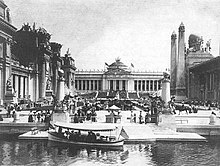
In 1900, the entire streetcar system was shut down by a several months-long strike, with significant unrest occurring in the city & violence against the striking workers.[31]
In 1904, the city hosted the World's Fair and the Olympics, becoming the first non-European city to host the games.[32] The formal name for the 1904 World's Fair was the Louisiana Purchase Exposition. Permanent facilities and structures remaining from the fair are located in Forest Park, and other notable structures within the park's boundaries include the St. Louis Art Museum, the St. Louis Zoo and the Missouri History Museum, as well as Tower Grove Park and the Botanical Gardens.
After the Civil War, social and racial discrimination in housing and employment were common in St. Louis. In 1916, during the Jim Crow Era, St. Louis passed a residential segregation ordinance[33] saying that if 75% of the residents of a neighborhood were of a certain race, no one from a different race was allowed to move in.[34] That ordinance was struck down in a court challenge, by the NAACP,[35] after which racial covenants were used to prevent the sale of houses in certain neighborhoods to "persons not of Caucasian race".[clarification needed] Again, St. Louisans offered a lawsuit in challenge, and such covenants were ruled unconstitutional by the U.S. Supreme Court in 1948 in Shelley v. Kraemer.[36]
In 1926, Douglass University, a historically black university was founded by B. F. Bowles in St. Louis, and at the time no other college in St. Louis County admitted black students.[37]
In the first half of the 20th century, St. Louis was a destination in the Great Migration of African Americans from the rural South seeking better opportunities. During World War II, the NAACP campaigned to integrate war factories. In 1964, civil rights activists protested at the construction of the Gateway Arch to publicize their effort to gain entry for African Americans into the skilled trade unions, where they were underrepresented. The Department of Justice filed the first suit against the unions under the Civil Rights Act of 1964.
Between 1900 and 1929, St. Louis, had about 220 automakers, close to 10 percent of all American carmakers, about half of which built cars exclusively in St. Louis. Notable names include Dorris, Gardner and Moon.[38]
In the first part of the century, St. Louis had some of the worst air pollution in the United States. In April 1940, the city banned the use of soft coal mined in nearby states. The city hired inspectors to ensure that only anthracite was burned. By 1946, the city had reduced air pollution by about 75%.[39]

De jure educational segregation continued into the 1950s, and de facto segregation continued into the 1970s, leading to a court challenge and interdistrict desegregation agreement. Students have been bused mostly from the city to county school districts to have opportunities for integrated classes, although the city has created magnet schools to attract students.[40]
St. Louis, like many Midwestern cities, expanded in the early 20th century due to industrialization, which provided jobs to new generations of immigrants and migrants from the South. It reached its peak population of 856,796 at the 1950 census.[41] Suburbanization from the 1950s through the 1990s dramatically reduced the city's population, as did restructuring of industry and loss of jobs. The effects of suburbanization were exacerbated by the small geographical size of St. Louis due to its earlier decision to become an independent city, and it lost much of its tax base. During the 19th and 20th century, most major cities aggressively annexed surrounding areas as residential development occurred away from the central city; however, St. Louis was unable to do so.
Several urban renewal projects were built in the 1950s, as the city worked to replace old and substandard housing. Some of these were poorly designed and resulted in problems. One prominent example, Pruitt–Igoe, became a symbol of failure in public housing, and was torn down less than two decades after it was built.
Since the 1980s, several revitalization efforts have focused on Downtown St. Louis.
21st century
The urban revitalization projects that started in the 1980s continued into the new century. The city's old garment district, centered on Washington Avenue in the Downtown and Downtown West neighborhoods, experienced major development starting in the late 1990s as many of the old factory and warehouse buildings were converted into lofts. The American Planning Association designated Washington Avenue as one of 10 Great Streets for 2011.[42] The Cortex Innovation Community, located within the city's Central West End neighborhood, was founded in 2002 and has become a multi-billion dollar economic engine for the region, with companies such as Microsoft and Boeing currently leasing office space.[43][44] The Forest Park Southeast neighborhood in the central corridor has seen major investment starting in the early 2010s. Between 2013 and 2018, over $50 million worth of residential construction has been built in the neighborhood.[45] The population of the neighborhood has increased by 19% from the 2010 to 2020 Census.[46]
The St. Louis Rams of the National Football League controversially returned to Los Angeles in 2016. The city of St. Louis sued the NFL in 2017, alleging the league breached its own relocation guidelines to profit at the expense of the city. In 2021, the NFL and Rams owner Stan Kroenke agreed to settle out of court with the city for $790 million.[47][48]
Geography
Landmarks
| Name | Description | Photo |
|---|---|---|
| Gateway Arch | At 630 feet (190 m), the Gateway Arch is the world's tallest arch and tallest human-made monument in the Western Hemisphere.[49] Built as a monument to the westward expansion of the United States, it is the centerpiece of Gateway Arch National Park which was known as Jefferson National Expansion Memorial until 2018. | 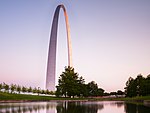
|
| St. Louis Art Museum | Built for the 1904 World's Fair, with a building designed by Cass Gilbert, the museum houses paintings, sculptures, and cultural objects. The museum is located in Forest Park, and admission is free. | 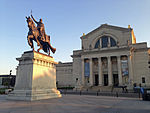
|
| Missouri Botanical Garden | Founded in 1859, the Missouri Botanical Garden is one of the oldest botanical institutions in the United States and a National Historic Landmark. It spans 79 acres in the Shaw neighborhood, including a 14-acre (5.7-hectare) Japanese garden and the Climatron geodesic dome conservatory. | 
|
| Cathedral Basilica of St. Louis | Dedicated in 1914, it is the mother church of the Archdiocese of St. Louis and the seat of its archbishop. The church is known for its large mosaic installation (which is one of the largest in the Western Hemisphere with 41.5 million pieces), burial crypts, and its outdoor sculpture. | 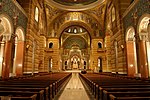
|
| City Hall | Located in Downtown West, City Hall was designed by Harvey Ellis in 1892 in the Renaissance Revival style. It is reminiscent of the Hôtel de Ville, Paris. | 
|
| Central Library | Completed in 1912, the Central Library building was designed by Cass Gilbert. It serves as the main location for the St. Louis Public Library. | 
|
| City Museum | City Museum is a play house museum, consisting largely of repurposed architectural and industrial objects, housed in the former International Shoe building in the Washington Avenue Loft District. | 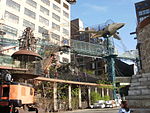
|
| Old Courthouse | Built in the 19th century, it served as a federal and state courthouse. The Scott v. Sandford case (resulting in the Dred Scott decision) was tried at the courthouse in 1846. | 
|
| St. Louis Science Center | Founded in 1963, it includes a science museum and a planetarium, and is situated in Forest Park. Admission is free. It is one of two science centers in the United States which offers free general admission. | 
|
| St. Louis Symphony | Founded in 1880, the St. Louis Symphony Orchestra is the second oldest symphony orchestra in the United States, preceded by the New York Philharmonic. Its principal concert venue is Powell Symphony Hall. | 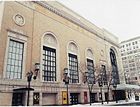
|
| Union Station | Built in 1888, it was the city's main passenger intercity train terminal. Once the world's largest and busiest train station, it was converted in the 1980s into a hotel, shopping center, and entertainment complex. Today, it also continues to serve local rail (MetroLink) transit passengers, with Amtrak service nearby. On December 25, 2019, the St. Louis Aquarium opened inside Union Station. The St. Louis Wheel, a 200 ft 42 gondola ferris wheel, is also located at Union Station. | 
|
| St. Louis Zoo | Built for the 1904 World's Fair, it is recognized as a leading zoo in animal management, research, conservation, and education. It is located in Forest Park, and admission is free. | 
|
Architecture
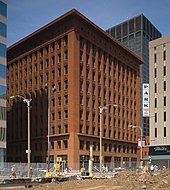
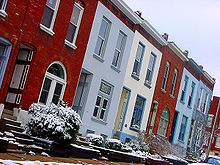
The architecture of St. Louis exhibits a variety of commercial, residential, and monumental architecture. St. Louis is known for the Gateway Arch, the tallest monument constructed in the United States at 630 feet (190 m).[50] The Arch pays homage to Thomas Jefferson and St. Louis's position as the gateway to the West. Architectural influences reflected in the area include French Colonial, German, early American, and modern architectural styles.
Several examples of religious structures are extant from the pre-Civil War period, and most reflect the common residential styles of the time. Among the earliest is the Basilica of St. Louis, King of France (referred to as the Old Cathedral). The Basilica was built between 1831 and 1834 in the Federal style. Other religious buildings from the period include SS. Cyril and Methodius Church (1857) in the Romanesque Revival style and Christ Church Cathedral (completed in 1867, designed in 1859) in the Gothic Revival style.
A few civic buildings were constructed during the early 19th century. The original St. Louis courthouse was built in 1826 and featured a Federal style stone facade with a rounded portico. However, this courthouse was replaced during renovation and expansion of the building in the 1850s. The Old St. Louis County Courthouse (known as the Old Courthouse) was completed in 1864 and was notable for having a cast iron dome and for being the tallest structure in Missouri until 1894. Finally, a customs house was constructed in the Greek Revival style in 1852, but was demolished and replaced in 1873 by the U.S. Customhouse and Post Office.
Because much of the city's commercial and industrial development was centered along the riverfront, many pre-Civil War buildings were demolished during construction of the Gateway Arch. The city's remaining architectural heritage of the era includes a multi-block district of cobblestone streets and brick and cast-iron warehouses called Laclede's Landing. Now popular for its restaurants and nightclubs, the district is located north of Gateway Arch along the riverfront. Other industrial buildings from the era include some portions of the Anheuser-Busch Brewery, which date to the 1860s.
St. Louis saw a vast expansion in variety and number of religious buildings during the late 19th century and early 20th century. The largest and most ornate of these is the Cathedral Basilica of St. Louis, designed by Thomas P. Barnett and constructed between 1907 and 1914 in the Neo-Byzantine style. The St. Louis Cathedral, as it is known, has one of the largest mosaic collections in the world. Another landmark in religious architecture of St. Louis is the St. Stanislaus Kostka, which is an example of the Polish Cathedral style. Among the other major designs of the period were St. Alphonsus Liguori (known as The Rock Church) (1867) in the Gothic Revival and Second Presbyterian Church of St. Louis (1900) in Richardsonian Romanesque.
By the 1900 census, St. Louis was the fourth largest city in the country. In 1904, the city hosted a world's fair at Forest Park called the Louisiana Purchase Exposition. Its architectural legacy is somewhat scattered. Among the fair-related cultural institutions in the park are the St. Louis Art Museum designed by Cass Gilbert, part of the remaining lagoon at the foot of Art Hill, and the Flight Cage at the St. Louis Zoo. The Missouri History Museum was built afterward, with the profit from the fair. But 1904 left other assets to the city, like Theodore Link's 1894 St. Louis Union Station, and an improved Forest Park.
One US Bank Plaza, the local headquarters for US Bancorp, was constructed in 1976 in the structural expressionist style. Several notable postmodern commercial skyscrapers were built downtown in the 1970s and 1980s, including the former AT&T building at 909 Chestnut Street (1986), and One Metropolitan Square (1989), which is the tallest building in St. Louis.
During the 1990s, St. Louis saw the construction of the largest United States courthouse by area, the Thomas F. Eagleton United States Courthouse(2000). The Eagleton Courthouse is home to the United States District Court for the Eastern District of Missouri and the United States Court of Appeals for the Eighth Circuit. The most recent high-rise buildings in St. Louis include two residential towers: One Hundred in the Central West End neighborhood and One Cardinal Way in the Downtown neighborhood.
Neighborhoods

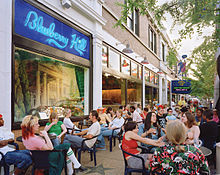
The city is divided into 79 officially-recognized neighborhoods.[51]
Topography
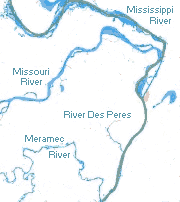
According to the United States Census Bureau, St. Louis has a total area of 66 square miles (170 km2), of which 62 square miles (160 km2) is land and 4.1 square miles (11 km2) (6.2%) is water.[52] The city is built on bluffs and terraces that rise 100–200 feet above the western banks of the Mississippi River, in the Midwestern United States just south of the Missouri-Mississippi confluence. Much of the area is a fertile and gently rolling prairie that features low hills and broad, shallow valleys. Both the Mississippi River and the Missouri River have cut large valleys with wide flood plains.
Limestone and dolomite of the Mississippian epoch underlie the area, and parts of the city are karst in nature. This is particularly true of the area south of downtown, which has numerous sinkholes and caves. Most of the caves in the city have been sealed, but many springs are visible along the riverfront. Coal, brick clay, and millerite ore were once mined in the city. The predominant surface rock, known as St. Louis limestone, is used as dimension stone and rubble for construction.
Near the southern boundary of the city of St. Louis (separating it from St. Louis County) is the River des Peres, practically the only river or stream within the city limits that is not entirely underground.[53] Most of River des Peres was confined to a channel or put underground in the 1920s and early 1930s. The lower section of the river was the site of some of the worst flooding of the Great Flood of 1993.
The city's eastern boundary is the Mississippi River, which separates Missouri from Illinois. The Missouri River forms the northern line of St. Louis County, except for a few areas where the river has changed its course. The Meramec River forms most of its southern line.
Climate

The urban area of St. Louis has a humid subtropical climate (Köppen: Cfa); however, its metropolitan region even to the south may present a hot-summer humid continental climate (Dfa), which shows the effect of the urban heat island in the city. The city experiences hot, humid summers and chilly to cold winters. It is subject to both cold Arctic air and hot, humid tropical air from the Gulf of Mexico. The average annual temperature recorded at nearby Lambert–St. Louis International Airport, is 57.4 °F (14.1 °C). 100 and 0 °F (38 and −18 °C) temperatures can be seen on an average 3 and 1 days per year, respectively. Precipitation averages 41.70 inches (1,100 mm), but has ranged from 20.59 in (523 mm) in 1953 to 61.24 in (1,555 mm) in 2015. The highest recorded temperature in St. Louis was 115 °F (46 °C) on July 14, 1954, and the lowest was −22 °F (−30 °C) on January 5, 1884.
St. Louis experiences thunderstorms 48 days a year on average.[54] Especially in the spring, these storms can often be severe, with high winds, large hail and tornadoes. Lying within the hotbed of Tornado Alley, St. Louis is one of the most frequently tornado-struck metropolitan areas in the U.S. and has an extensive history of damaging tornadoes. Severe flooding, such as the Great Flood of 1993, may occur in spring and summer; the (often rapid) melting of thick snow cover upstream on the Missouri or Mississippi Rivers can contribute to springtime flooding.
| Climate data for St. Louis, Missouri (Lambert–St. Louis Int'l), 1991−2020 normals,[a] extremes 1874−present[b] | |||||||||||||
|---|---|---|---|---|---|---|---|---|---|---|---|---|---|
| Month | Jan | Feb | Mar | Apr | May | Jun | Jul | Aug | Sep | Oct | Nov | Dec | Year |
| Record high °F (°C) | 77 (25) |
85 (29) |
92 (33) |
93 (34) |
98 (37) |
108 (42) |
115 (46) |
110 (43) |
104 (40) |
94 (34) |
86 (30) |
76 (24) |
115 (46) |
| Mean maximum °F (°C) | 64.7 (18.2) |
71.0 (21.7) |
79.4 (26.3) |
86.4 (30.2) |
90.4 (32.4) |
95.5 (35.3) |
99.2 (37.3) |
99.1 (37.3) |
93.4 (34.1) |
87.0 (30.6) |
75.5 (24.2) |
66.9 (19.4) |
100.7 (38.2) |
| Mean daily maximum °F (°C) | 40.4 (4.7) |
45.8 (7.7) |
56.6 (13.7) |
68.0 (20.0) |
77.1 (25.1) |
85.9 (29.9) |
89.6 (32.0) |
88.3 (31.3) |
81.1 (27.3) |
69.2 (20.7) |
55.5 (13.1) |
44.5 (6.9) |
66.8 (19.3) |
| Daily mean °F (°C) | 32.1 (0.1) |
36.7 (2.6) |
46.6 (8.1) |
57.5 (14.2) |
67.5 (19.7) |
76.5 (24.7) |
80.4 (26.9) |
78.8 (26.0) |
71.0 (21.7) |
59.1 (15.1) |
46.5 (8.1) |
36.5 (2.5) |
57.4 (14.1) |
| Mean daily minimum °F (°C) | 23.8 (−4.6) |
27.6 (−2.4) |
36.7 (2.6) |
47.0 (8.3) |
57.9 (14.4) |
67.2 (19.6) |
71.1 (21.7) |
69.3 (20.7) |
60.9 (16.1) |
49.1 (9.5) |
37.4 (3.0) |
28.5 (−1.9) |
48.0 (8.9) |
| Mean minimum °F (°C) | 4.4 (−15.3) |
9.6 (−12.4) |
17.8 (−7.9) |
32.2 (0.1) |
43.5 (6.4) |
55.5 (13.1) |
61.4 (16.3) |
60.1 (15.6) |
47.1 (8.4) |
33.6 (0.9) |
22.0 (−5.6) |
11.0 (−11.7) |
1.2 (−17.1) |
| Record low °F (°C) | −22 (−30) |
−18 (−28) |
−5 (−21) |
20 (−7) |
31 (−1) |
43 (6) |
51 (11) |
47 (8) |
32 (0) |
21 (−6) |
1 (−17) |
−16 (−27) |
−22 (−30) |
| Average precipitation inches (mm) | 2.59 (66) |
2.23 (57) |
3.50 (89) |
4.73 (120) |
4.82 (122) |
4.49 (114) |
3.93 (100) |
3.38 (86) |
2.96 (75) |
3.15 (80) |
3.42 (87) |
2.50 (64) |
41.70 (1,059) |
| Average snowfall inches (cm) | 5.7 (14) |
4.3 (11) |
2.3 (5.8) |
0.2 (0.51) |
0.0 (0.0) |
0.0 (0.0) |
0.0 (0.0) |
0.0 (0.0) |
0.0 (0.0) |
0.0 (0.0) |
0.9 (2.3) |
3.2 (8.1) |
16.6 (42) |
| Average precipitation days (≥ 0.01 in) | 9.3 | 8.7 | 10.8 | 11.5 | 12.6 | 9.8 | 8.9 | 8.4 | 7.3 | 8.5 | 9.0 | 9.0 | 113.8 |
| Average snowy days (≥ 0.1 in) | 4.7 | 3.9 | 1.7 | 0.2 | 0.0 | 0.0 | 0.0 | 0.0 | 0.0 | 0.0 | 0.8 | 3.2 | 14.5 |
| Average relative humidity (%) | 73.0 | 72.0 | 68.3 | 63.5 | 66.5 | 67.1 | 68.0 | 70.0 | 71.6 | 68.7 | 72.2 | 75.8 | 69.7 |
| Average dew point °F (°C) | 20.1 (−6.6) |
24.1 (−4.4) |
33.1 (0.6) |
42.3 (5.7) |
52.9 (11.6) |
62.1 (16.7) |
66.6 (19.2) |
65.1 (18.4) |
58.6 (14.8) |
46.0 (7.8) |
36.0 (2.2) |
25.5 (−3.6) |
44.4 (6.9) |
| Mean monthly sunshine hours | 161.2 | 158.3 | 198.3 | 223.5 | 266.5 | 291.9 | 308.9 | 269.8 | 236.1 | 208.4 | 140.9 | 129.9 | 2,593.7 |
| Percent possible sunshine | 53 | 53 | 53 | 56 | 60 | 66 | 68 | 64 | 63 | 60 | 47 | 44 | 58 |
| Average ultraviolet index | 1.7 | 2.7 | 4.5 | 6.4 | 7.9 | 9.0 | 9.1 | 8.2 | 6.3 | 4.0 | 2.3 | 1.6 | 5.3 |
| Source 1: NOAA (relative humidity, dew point, and sun 1961−1990)[56][57][58] | |||||||||||||
| Source 2: UV Index Today (1995 to 2022)[59] | |||||||||||||
Flora and fauna
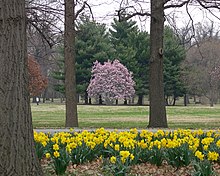

Before the founding of the city, the area was mostly prairie and open forest. Native Americans maintained this environment, good for hunting, by burning underbrush. Trees are mainly oak, maple, and hickory, similar to the forests of the nearby Ozarks; common understory trees include eastern redbud, serviceberry, and flowering dogwood. Riparian areas are forested with mainly American sycamore.
Most of the residential areas of the city are planted with large native shade trees. The largest native forest area is found in Forest Park. In autumn, the changing color of the trees is notable. Most species here are typical of the eastern woodland, although numerous decorative non-native species are found. The most notable invasive species is Japanese honeysuckle, which officials are trying to manage because of its damage to native trees. It is removed from some parks.
Large mammals found in the city include urbanized coyotes and white-tailed deer. Eastern gray squirrel, cottontail rabbit, and other rodents are abundant, as well as the nocturnal Virginia opossum. Large bird species are abundant in parks and include Canada goose, mallard duck, as well as shorebirds, including the great egret and great blue heron. Gulls are common along the Mississippi River; these species follow barge traffic.
Winter populations of bald eagles are found along the Mississippi River around the Chain of Rocks Bridge. The city is on the Mississippi Flyway, used by migrating birds, and has a large variety of small bird species, common to the eastern U.S. The Eurasian tree sparrow, an introduced species, is limited in North America to the counties surrounding St. Louis. The city has special sites for birdwatching of migratory species, including Tower Grove Park.
Frogs are found in the springtime, especially after extensive wet periods. Common species include the American toad and species of chorus frogs called spring peepers, which are found in nearly every pond. Some years have outbreaks of cicadas or ladybugs. Mosquitoes, no-see-ums, and houseflies are common insect nuisances, especially in July and August; because of this, windows are almost always fitted with screens. Invasive populations of honeybees have declined in recent years. Numerous native species of pollinator insects have recovered to fill their ecological niche, and armadillos are seen throughout the St. Louis area.[60]
Demographics
| Census | Pop. | Note | %± |
|---|---|---|---|
| 1810 | 1,600 | — | |
| 1830 | 4,977 | — | |
| 1840 | 16,469 | 230.9% | |
| 1850 | 77,860 | 372.8% | |
| 1860 | 160,773 | 106.5% | |
| 1870 | 310,864 | 93.4% | |
| 1880 | 350,518 | 12.8% | |
| 1890 | 451,770 | 28.9% | |
| 1900 | 575,238 | 27.3% | |
| 1910 | 687,029 | 19.4% | |
| 1920 | 772,897 | 12.5% | |
| 1930 | 821,960 | 6.3% | |
| 1940 | 816,048 | −0.7% | |
| 1950 | 856,796 | 5.0% | |
| 1960 | 750,026 | −12.5% | |
| 1970 | 622,236 | −17.0% | |
| 1980 | 453,805 | −27.1% | |
| 1990 | 396,685 | −12.6% | |
| 2000 | 348,189 | −12.2% | |
| 2010 | 319,294 | −8.3% | |
| 2020 | 301,578 | −5.5% | |
| 2023 (est.) | 281,754 | [9] | −6.6% |
| U.S. Decennial Census[61] 2020 Census[8] | |||


St. Louis grew slowly until the American Civil War, when industrialization and immigration sparked a boom. Mid-19th century immigrants included many Irish and Germans; later there were immigrants from southern and eastern Europe. In the early 20th century, African American and white migrants came from the South; the former as part of the Great Migration out of rural areas of the Deep South. Many came from Mississippi and Arkansas. Italians, Serbians, Lebanese, Syrians, and Greeks settled in St. Louis by the late 19th-Century.[62]
After years of immigration, migration, and expansion, the city reached its peak population in 1950. That year, the Census Bureau reported St. Louis's population as 82% White and 17.9% African American.[63] After World War II, St. Louis began losing population to the suburbs, first because of increased demand for new housing, unhappiness with city services, ease of commuting by highways, and later, white flight.[64] St. Louis's population decline has resulted in a significant increase of abandoned residential housing units and vacant lots throughout the city proper; this blight has attracted much wildlife (such as deer and coyotes) to the many abandoned overgrown lots.

St. Louis has lost 64.0% of its population since the 1950 United States census. Detroit, Michigan, and Youngstown, Ohio, are the only other cities that have had population declines of at least 60% in the same time frame. The population of the city of St. Louis has been in decline since the 1950 census; during this period the population of the St. Louis Metropolitan Area, which includes more than one county, has grown every year and continues to do so. A big factor in the decline has been the rapid increase in suburbanization.
According to the 2010 United States census, St. Louis had 319,294 people living in 142,057 households, of which 67,488 households were families. The population density was 5,158.2 people per square mile (1,991.6 people/km2). About 24% of the population was 19 or younger, 9% were 20 to 24, 31% were 25 to 44, 25% were 45 to 64, and 11% were 65 or older. The median age was about 34 years.
The African-American population is concentrated in the north side of the city (the area north of Delmar Boulevard is 94.0% black, compared with 35.0% in the central corridor and 26.0% in the south side of St. Louis[65]). Among the Asian-American population in the city, the largest ethnic group is Vietnamese (0.9%), followed by Chinese (0.6%) and Indians (0.5%). The Vietnamese community has concentrated in the Dutchtown neighborhood of south St. Louis; Chinese are concentrated in the Central West End.[66] People of Mexican descent are the largest Latino group, and make up 2.2% of St. Louis's population. They have the highest concentration in the Dutchtown, Benton Park West (Cherokee Street), and Gravois Park neighborhoods.[67] People of Italian descent are concentrated in The Hill.
In 2000, the median income for a household in the city was $29,156, and the median income for a family was $32,585. Males had a median income of $31,106; females, $26,987. Per capita income was $18,108.
Some 19% of the city's housing units were vacant, and slightly less than half of these were vacant structures not for sale or rent.
In 2010, St. Louis's per-capita rates of online charitable donations and volunteerism were among the highest among major U.S. cities.[68]
As of 2010, 91.05% (270,934) of St. Louis city residents age 5 and older spoke English at home as a primary language, while 2.86% (8,516) spoke Spanish, 0.91% (2,713) Serbo-Croatian, 0.74% (2,200) Vietnamese, 0.50% (1,495) African languages, 0.50% (1,481) Chinese, and French was spoken as a main language by 0.45% (1,341) of the population over the age of five. In total, 8.95% (26,628) of St. Louis's population age 5 and older spoke a mother language other than English.[69]
| Racial composition | 2020[70] | 2010[71] | 2000[72] | 1990[63] | 1970[63] | 1940[63] |
|---|---|---|---|---|---|---|
| White | 43.9% | 43.9% | 43.9% | 50.9% | 58.7% | 86.6% |
| —Non-Hispanic | 42.9% | 42.2% | 43.0%[73] | 50.2% | 57.9%[74] | 86.4% |
| Black | 43.0% | 49.2% | 51.2% | 47.5% | 40.9% | 13.3% |
| Hispanic or Latino (of any race) | 5.1% | 3.5% | 2.0% | 1.3% | 1.0%[74] | 0.2% |
| Asian | 4.1% | 2.9% | 2.0% | 0.9% | 0.2% | (X) |
Bosnian population
About fifteen families from Bosnia settled in St. Louis between 1960 and 1970. After the Bosnian War started in 1992, more Bosnian refugees began arriving and by 2000, tens of thousands of Bosnian refugees settled in St. Louis with the help of Catholic aid societies. Many of them were professionals and skilled workers who had to take any job opportunity to be able to support their families. Most Bosnian refugees are Muslim, ethnically Bosniaks (87%); they have settled primarily in south St. Louis[75] and South County. Bosnian-Americans are well integrated into the city, developing many businesses and ethnic/cultural organizations.[76]
An estimated 70,000 Bosnians live in the metro area, which is tied with Chicago for largest population of Bosnians in the United States and the largest Bosnian population outside their homeland. The highest concentration of Bosnians is in the neighborhood of Bevo Mill and in Affton, Mehlville, and Oakville of south St. Louis County.[77][78]
Crime
Since 2014 the city of St. Louis has had, as of April 2017, one of the highest murder rates, per capita, in the United States,[79] with 188 homicides in 2015 (59.3 homicides per 100,000)[80][81] and ranks No. 13 of the most dangerous cities in the world by homicide rate. Detroit, Flint, Memphis, Birmingham, and Baltimore have higher overall violent crime rates than St. Louis, when comparing other crimes such as rape, robbery, and aggravated assault.[80][82] Despite these high crime rates relative to other American cities, St. Louis index crime rates have declined almost every year since the peak in 1993 (16,648), to the 2014 level of 7,931 (which is the sum of violent crimes and property crimes) per 100,000. In 2015, the index crime rate reversed the 2005–2014 decline to a level of 8,204. Between 2005 and 2014, violent crime has declined by 20%, although rates of violent crime remains 6 times higher than the United States national average and property crime in the city remains 2 1⁄2 times the national average.[83] St. Louis has a higher homicide rate than the rest of the U.S. for both whites and blacks and a higher proportion committed by males. As of October 2016, 7 of the homicide suspects were white, 95 black, 0 Hispanic, 0 Asian and 1 female out of the 102 suspects. In 2016, St. Louis was the most dangerous city in the United States with populations of 100,000 or more, ranking 1st in violent crime and 2nd in property crime. It was also ranked 6th of the most dangerous of all establishments in the United States, and East St. Louis, a suburb of the city itself, was ranked 1st.[84][85] The St. Louis Police Department at the end of 2016 reported a total of 188 murders for the year, the same number of homicides that had occurred in the city in 2015.[86] According to the STLP At the end of 2017, St. Louis had 205 murders but the city recorded only 159 inside St. Louis city limits.[87][88] The new Chief of Police, John Hayden said two-thirds (67%) of all the murders and one-half of all the assaults are concentrated in a triangular area in the North part of the city.[87]
Yet another factor when comparing the murder rates of St. Louis and other cities is the manner of drawing municipal boundaries. While many other municipalities have annexed many suburbs, St. Louis has not annexed as much suburban area as most American cities. According to a 2018 estimate, the St. Louis metro area included about 3 million residents and the city included about 300,000 residents. Therefore, the city contains about ten percent of the metro population, a low ratio indicating that the municipal boundaries include only a small part of the metro population.[89]
Economy
The gross domestic product of Greater St. Louis was $209.9 billion in 2022, up from $192.9 billion the previous year.[16] Greater St. Louis had a GDP per capita of $68,574 in 2021, up 10% from the previous year.[90][91] In 2007, manufacturing in the city conducted nearly $11 billion in business, followed by the health care and social service industry with $3.5 billion; professional or technical services with $3.1 billion; and the retail trade with $2.5 billion. The health care sector was the area's biggest employer with 34,000 workers, followed by administrative and support jobs, 24,000; manufacturing, 21,000, and food service, 20,000.[92]
Major companies and institutions

As of 2022, the St. Louis Metropolitan Area is home to seven Fortune 500 companies. They include Centene, Emerson Electric, Reinsurance Group of America, Edward Jones, Olin, Graybar Electric, and Ameren.[93]
Other notable corporations headquartered in the region include Arch Coal, Bunge Limited, Wells Fargo Advisors (formerly A.G. Edwards), Energizer Holdings, Patriot Coal, Post Foods, United Van Lines, and Mayflower Transit, Post Holdings, Olin, Enterprise Holdings (a parent company of several car rental companies). Notable corporations with operations in St. Louis include Cassidy Turley, Kerry Group, Mastercard, TD Ameritrade, BMO Harris Bank, and World Wide Technology.
Health care and biotechnology institutions with operations in St. Louis include Pfizer, the Donald Danforth Plant Science Center, the Solae Company, Sigma-Aldrich, and Multidata Systems International. General Motors manufactures automobiles in Wentzville, while an earlier plant, known as the St. Louis Truck Assembly, built GMC automobiles from 1920 until 1987. Chrysler closed its St. Louis Assembly production facility in nearby Fenton, Missouri and Ford closed the St. Louis Assembly Plant in Hazelwood.
Several once-independent pillars of the local economy have been purchased by other corporations. Among them are Anheuser-Busch, purchased by Belgium-based InBev; Missouri Pacific Railroad, which was headquartered in St. Louis, merged with the Omaha, Nebraska-based Union Pacific Railroad in 1982;[94] McDonnell Douglas, whose operations are now part of Boeing Defense, Space & Security;[95] Trans World Airlines, which was headquartered in the city for its last decade of existence, prior to being acquired by American Airlines; Mallinckrodt, purchased by Tyco International; and Ralston Purina, now a wholly owned subsidiary of Nestlé.[96] The May Department Stores Company (which owned Famous-Barr and Marshall Field's stores) was purchased by Federated Department Stores, which has its regional headquarters in the area. The Federal Reserve Bank of St. Louis in downtown is one of two federal reserve banks in Missouri.[97] Most of the assets of Furniture Brands International were sold to Heritage Home Group in 2013, which moved to North Carolina.[98][99]

St. Louis is a center of medicine and biotechnology.[100] The Washington University School of Medicine is affiliated with Barnes-Jewish Hospital, the fifth largest hospital in the world. Both institutions operate the Alvin J. Siteman Cancer Center.[101] The School of Medicine also is affiliated with St. Louis Children's Hospital, one of the country's top pediatric hospitals.[102] Both hospitals are owned by BJC HealthCare. The McDonnell Genome Institute at Washington University played a major role in the Human Genome Project.[103] Saint Louis University Medical School is affiliated with SSM Health's Cardinal Glennon Children's Hospital and Saint Louis University Hospital. It also has a cancer center, vaccine research center, geriatric center, and a bioethics institute. Several different organizations operate hospitals in the area, including BJC HealthCare, Mercy, SSM Health Care, and Tenet.
Cortex Innovation Community in Midtown neighborhood is the largest innovation hub in the midwest. Cortex is home to offices of Square, Microsoft, Aon, Boeing, and Centene. Cortex has generated 3,800 tech jobs in 14 years. Once built out, projections are for it to make $2 billion in development and create 13,000 jobs for the region.[104][105]
Boeing employs nearly 15,000 people in its north St. Louis campus, headquarters to its defense unit. In 2013, the company said it would move about 600 jobs from Seattle, where labor costs have risen, to a new IT center in St. Louis.[106][107] Other companies, such as LaunchCode and LockerDome, think the city could become the next major tech hub.[108] Programs such as Arch Grants are attracting new startups to the region.[109]
According to the St. Louis Business Journal, the top employers in the St. Louis metropolitan area as of 1 April 2021, are:[110]
| # | Employer | # of employees |
|---|---|---|
| 1 | BJC Health Care | 29,595 |
| 2 | Washington University | 18,805 |
| 3 | Mercy | 15,410 |
| 4 | Boeing Defense, Space & Security | 14,865 |
| 5 | SSM Health | 14,600 |
According to St. Louis's 2022 Annual Comprehensive Financial Report (June 30),[111] the top employers in the city only are (representing 82,481 people, or 18.74% of the city's total employment of 440,000):
| # | Employer | # of Employees |
|---|---|---|
| 1 | Washington University | 19,380 |
| 2 | Barnes Jewish Hospital | 18,920 |
| 3 | Saint Louis University | 9,152 |
| 4 | City of St. Louis | 7,033 |
| 5 | Defense Finance and Accounting Service | 6,051 |
| 6 | Wells Fargo Advisors | 5,801 |
| 7 | US Postal Service | 4,960 |
| 8 | St. Louis Board of Education | 4,131 |
| 9 | SSM SLUH | 3,983 |
| 9 | State of Missouri | 3,259 |
Arts and culture
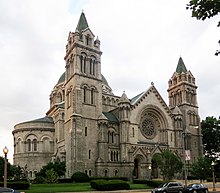
The same year as the 1904 World's Fair, the Strassberger Music Conservatory Building was constructed at 2300 Grand. Otto Wilhelmi was the architect. In 1911, the conservatory had over 1,100 students.[112] The building is presently in the National Register of Historic Places.[113] A well known graduate was Alfonso D'Artega.[114]
With its French past and waves of Catholic immigrants in the 19th and 20th centuries, from Ireland, Germany and Italy, St. Louis is a major center of Roman Catholicism in the United States. St. Louis also boasts the largest Ethical Culture Society in the United States and is one of the most generous cities in the United States, ranking ninth in 2013.[115] Several places of worship in the city are noteworthy, such as the Cathedral Basilica of St. Louis, home of the world's largest mosaic installation.[116]

Other notable churches include the Basilica of St. Louis, King of France, the oldest Roman Catholic cathedral west of the Mississippi River and the oldest church in St. Louis; the St. Louis Abbey, whose distinctive architectural style garnered multiple awards at the time of its completion in 1962; and St. Francis de Sales Oratory, a neo-Gothic church completed in 1908 in South St. Louis and the second largest church in the city.
The city is identified with music and the performing arts, especially its association with blues, jazz, and ragtime. St. Louis is home to the St. Louis Symphony, the second oldest symphony orchestra in the United States. Until 2010, it was also home to KFUO-FM, one of the oldest classical music FM radio stations west of the Mississippi River.[117] Opera Theatre of St. Louis has been called "one of America's best summer festivals" by the Washington Post. Former general director Timothy O'Leary was known for drawing the community into discussions of challenging operas. John Adams's "The Death of Klinghoffer", which touched off protests and controversy when performed by the Metropolitan Opera in 2014, had no such problems in St. Louis three years before, because the company fostered a citywide discussion, with interfaith dialogues addressing the tough issues of terrorism, religion and the nature of evil that the opera brings up. St. Louis's Jewish Community Relations Council gave O'Leary an award. Under O'Leary, the company—always known for innovative work—gave second chances to other major American operas, such as John Corigliano's "The Ghosts of Versailles", presented in 2009 in a smaller-scale version.[118]
The Gateway Arch anchors downtown St. Louis and a historic center that includes: the Federal courthouse where the Dred Scott case was first argued, an expanded public library, major churches and businesses, and retail. An increasing downtown residential population has taken to adapted office buildings and other historic structures. In nearby University City is the Delmar Loop, ranked by the American Planning Association as a "great American street" for its variety of shops and restaurants, and the Tivoli Theater, all within walking distance.
Unique city and regional cuisine reflecting various immigrant groups include toasted ravioli, gooey butter cake, provel cheese, the slinger, the Gerber sandwich, and the St. Paul sandwich. Some St. Louis chefs have begun emphasizing use of local produce, meats and fish, and neighborhood farmers' markets have become more popular. Artisan bakeries, salumeria, and chocolatiers also operate in the city.
St. Louis-style pizza has thin crust, provel cheese, and is cut in small squares.[119] Frozen-custard purveyor Ted Drewes offers its "Concrete": frozen custard blended with any combination of dozens of ingredients into a mixture so thick that a spoon inserted into the custard does not fall if the cup is inverted.[120]
Sports
St. Louis is home to the St. Louis Cardinals of Major League Baseball and the St. Louis Blues of the National Hockey League. In 2019, it became the eighth North American city to have won titles in all four major leagues (MLB, NBA, NFL, and NHL) when the Blues won the Stanley Cup championship. It also has notable and collegiate-level soccer teams and is one of three American cities to have hosted the Summer Olympic Games. A third major team, the St. Louis City SC of Major League Soccer, began play in 2023.
Professional sports
Pro teams in the St. Louis area include:

The St. Louis Cardinals are one of the most successful franchises in Major League Baseball.[121] The Cardinals have won 19 National League (NL) titles (the most pennants for the league franchise in one city) and 11 World Series titles (second to the New York Yankees and the most by any NL franchise), recently in 2011.[122] They play at Busch Stadium. Previously, the St. Louis Browns played in the American League (AL) from 1902 to 1953, before moving to Baltimore, Maryland to become the current incarnation of the Orioles. The 1944 World Series was an all-St. Louis World Series, matching up the St. Louis Cardinals and St. Louis Browns at Sportsman's Park, won by the Cardinals in six games. It was the third and final time that the teams shared a home field. St. Louis also was home to the St. Louis Stars (baseball), also known as the St. Louis Giants from 1906 to 1921, who played in the Negro league baseball from 1920 to 1931 and won championships in 1928, 1930, and 1931, and the St. Louis Maroons who played in both the Union Association in 1884 and the National League from 1885 to 1889. In 1884, The St. Louis Maroons won the Union Association pennant and started the season with 20 straight wins, a feat that was not surpassed by any major professional sports team in the United States until the 2015-16 Golden State Warriors season when they started their NBA season with 24 straight wins.

The St. Louis Blues of the National Hockey League (NHL) play at the Enterprise Center. They were one of the six teams added to the NHL in the 1967 expansion. The Blues went to the Stanley Cup finals in their first three years, but got swept every time. Although they were the first 1967 expansion team to make the Stanley Cup Finals, they were also the last of the 1967 expansion teams to win the Stanley Cup. They finally won their first Stanley Cup in 2019 after beating the Boston Bruins in the final. This championship made St. Louis the eighth city to win a championship in each of the four major U.S. sports. Prior to the Blues, the city was home to the St. Louis Eagles. The team played in the 1934–35 season.
St. Louis has been home to four National Football League (NFL) teams. The St. Louis All-Stars played in the city in 1923, the St. Louis Gunners in 1934, the St. Louis Cardinals from 1960 to 1987, and the St. Louis Rams from 1995 to 2015. The football Cardinals advanced to the NFL playoffs four times (1964, 1974, 1975 and 1982), never hosting in any appearance. They did, however, win the 1964 Playoff Bowl for third place against the Green Bay Packers by a score of 24–17. The Cardinals moved to Phoenix, Arizona, in 1988. The Rams played at the Edward Jones Dome from 1995 to 2015 and won Super Bowl XXXIV in 2000. They also went to Super Bowl XXXVI but lost to the New England Patriots. The Rams then returned to Los Angeles in 2016.
The St. Louis Hawks of the National Basketball Association (NBA) played at Kiel Auditorium from 1955 to 1968. They won the NBA championship in 1958 and played in three other NBA Finals: 1957, 1960, and 1961. In 1968 the Hawks moved to Atlanta. St. Louis was also the home to the St. Louis Bombers of the Basketball Association of America from 1946 to 1949 and the National Basketball Association from 1949 to 1950 and the Spirits of St. Louis of the American Basketball Association from 1974 to 1976 when the ABA and NBA merged.

Major League Soccer's St. Louis City SC began play in 2023 at CityPark. Their MLS Next Pro affiliate is St. Louis City SC 2, which began play in 2022 and also plays at CityPark. Formerly, USL Championship's Saint Louis FC played in the area from 2015 to 2020 at World Wide Technology Soccer Park.
The St. Louis BattleHawks of the XFL began play in 2020, using The Dome at America's Center as their home field. After a two-year hiatus of the league, the Battlehawks returned in 2023, when the XFL resumed play.
St. Louis hosts several minor league sports teams. The Gateway Grizzlies of the independent Frontier League play in the area in Sauget, IL. The St. Louis Trotters of the Independent Basketball Association play at Matthews-Dickey Boys and Girls Club. The St. Louis Ambush indoor soccer team plays in nearby St. Charles at the Family Arena as a part of the Major Arena Soccer League. The St. Louis Slam play in the Women's Football Alliance at Harlen C. Hunter Stadium.
The region hosts INDYCAR, NHRA drag racing, and NASCAR events at World Wide Technology Raceway at Gateway in Madison, Illinois. Thoroughbred flat racing events are hosted at Fairmount Park Racetrack near Collinsville, Illinois.
Amateur sports
St. Louis has hosted the Final Four of both the women's and men's college basketball NCAA Division I championship tournaments, and the Frozen Four collegiate ice hockey tournament. Saint Louis University has won 10 NCAA men's soccer championships, and the city has hosted the College Cup several times. In addition to collegiate soccer, many St. Louisans have played for the United States men's national soccer team, and 20 St. Louisans have been elected into the National Soccer Hall of Fame. St. Louis also is the origin of the sport of corkball, a type of baseball in which there is no base running.
Although the area does not have a National Basketball Association team, it hosts the St. Louis Phoenix, an American Basketball Association team.
Club Atletico Saint Louis, a semi-professional soccer team, competes within the National Premier Soccer League and plays out of St. Louis University High School Soccer Stadium.
Chess

St. Louis is home to the Saint Louis Chess Club where the U.S. Chess Championship is held. St. Louisan Rex Sinquefield founded the Chess Club and Scholastic Center of St. Louis (which was renamed as St. Louis Chess Club later) and moved the World Chess Hall of Fame to St. Louis in 2011. The Sinquefield Cup Tournament started at St. Louis in 2013. In 2014 the Sinquefield Cup was the highest-rated chess tournament of all time. Former U.S. Chess Champions Fabiano Caruana and Hikaru Nakamura have lived in St. Louis. Former women's chess champion Susan Polgar also resides in St. Louis.
Parks and recreation
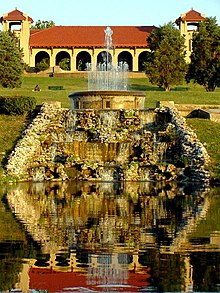
The city operates more than 100 parks, with amenities that include sports facilities, playgrounds, concert areas, picnic areas, and lakes. Forest Park, located on the western edge of city, is the largest, occupying 1,400 acres of land, making it almost twice as large as Central Park in New York City.[50] The park is home to five major institutions, including the St. Louis Art Museum, the St. Louis Zoo, the St. Louis Science Center, the Missouri History Museum, and the Muny amphitheatre.[50] Another significant park in the city is Gateway Arch National Park, which was known as Jefferson National Expansion Memorial until 2018 and is located on the riverfront in downtown St. Louis. The centerpiece of the park is the 630-foot (192 m) tall Gateway Arch, a National Memorial designed by noted architect Eero Saarinen and completed on October 28, 1965. Also part of the historic park is the Old Courthouse, where the first two trials of Dred Scott v. Sandford were held in 1847 and 1850.

Other notable parks in the city include the Missouri Botanical Garden, Tower Grove Park, Carondelet Park and Citygarden. The Missouri Botanical Garden, a private garden and botanical research facility, is a National Historic Landmark and one of the oldest botanical gardens in the United States.[50] The Garden features 79 acres of horticultural displays from around the world. This includes a Japanese strolling garden, Henry Shaw's original 1850 estate home and a geodesic dome called the Climatron.[50] Immediately south of the Missouri Botanical Garden is Tower Grove Park, a gift to the city by Henry Shaw. Citygarden is an urban sculpture park located in downtown St. Louis, with art from Fernand Léger, Aristide Maillol, Julian Opie, Tom Otterness, Niki de Saint Phalle, and Mark di Suvero.[123][124] The park is divided into three sections, each of which represent a different theme: river bluffs; flood plains; and urban gardens. Another downtown sculpture park is the Serra Sculpture Park, with the 1982 Richard Serra sculpture Twain.[125]
Government
St. Louis is one of the 41 independent cities in the U.S. that does not legally belong to any county.[126] St. Louis has a strong mayor–council government with legislative authority and oversight vested in the Board of Aldermen and with executive authority in the mayor and six other elected officials.[127] The Board of Aldermen is made up of 28 members (one elected from each of the city's wards) plus a board president who is elected citywide.[128] The 2014 fiscal year budget topped $1 billion for the first time, a 1.9% increase over the $985.2 million budget in 2013.[129] 238,253 registered voters lived in the city in 2012,[130] down from 239,247 in 2010, and 257,442 in 2008.[131]
Structure
| Citywide office[132][133] | Elected official |
|---|---|
| Mayor of St. Louis | Tishaura Jones |
| President of the Board of Aldermen | Megan Green |
| City Comptroller | Darlene Green |
| Recorder of Deeds | Michael Butler |
| Collector of Revenue | Gregory F.X. Daly |
| License Collector | Mavis T. Thompson |
| Treasurer | Adam Layne |
| Circuit Attorney | Gabe Gore |
| City of St. Louis Sheriff | Vernon Betts |

The mayor is the chief executive officer of the city and is responsible for appointing city department heads including; the director of public safety, the director of streets & traffic, the director of health, the director of human services, the director of the airport, the director of parks & recreation, the director of workforce development, the director of the Community Development Agency, the director of economic development, the director of public utilities, the director of the Civil Rights Enforcement Agency, the register, and the assessor, among other department-level or senior administrative positions. The President of the Board of Aldermen is the second highest-ranking official in the city. The President is the presiding officer of the Board of Aldermen which is the legislative branch of government of the city.
Municipal elections in St. Louis are held in odd-numbered years, with the primary elections in March and the general election in April. The mayor is elected in odd-numbered years following the United States presidential election, as are the aldermen representing odd-numbered wards. The president of the board of aldermen and the aldermen from even-numbered wards are elected in the off-years. The Democratic Party has dominated St. Louis city politics for decades. The city has not had a Republican mayor since 1949, and the last time a Republican was elected to another citywide office was in the 1970s. As of 2015, all 28 of the city's aldermen are Democrats.[134]
Forty-seven individuals have held the office of mayor of St. Louis, four of whom—William Carr Lane, John Fletcher Darby, John Wimer, and John How—served non-consecutive terms. The most terms served by a mayor was by Lane, who served 8 full terms plus the unexpired term of Darby. The current mayor is Tishaura Jones, who took office April 20, 2021, and is the first African-American woman to hold the post. She succeeded Lyda Krewson, the first female mayor of the city, who retired in 2021 after serving for four years. The longest-serving mayor was Francis Slay, who took office April 17, 2001, and left office April 18, 2017, a total of 16 years and six days over four terms in office. The shortest-serving mayor was Arthur Barret, who died 11 days after taking office.
Although St. Louis separated from St. Louis County in 1876, some mechanisms have been put in place for joint funding management and funding of regional assets. The St. Louis Zoo-Museum district collects property taxes from residents of both St. Louis City and County, and the funds are used to support cultural institutions including the St. Louis Zoo, St. Louis Art Museum and the Missouri Botanical Gardens. Similarly, the Metropolitan Sewer District provides sanitary and storm sewer service to the city and much of St. Louis County. The Bi-State Development Agency (now known as Metro) runs the region's MetroLink light rail system and bus system.
The City of St. Louis Sheriff's Office (STLSO or STLCSO) primarily provides security services for the courtrooms, as well as serving court documents and issuing gun carry permits. In 2022, they gained the ability to make arrests and traffic stops.[136]
State and federal government
| Year | Republican | Democratic | Third party | |||
|---|---|---|---|---|---|---|
| No. | % | No. | % | No. | % | |
| 2020 | 21,474 | 15.98% | 110,089 | 81.93% | 2,809 | 2.09% |
| 2016 | 20,832 | 15.72% | 104,235 | 78.68% | 7,420 | 5.60% |
| 2012 | 22,943 | 15.93% | 118,780 | 82.45% | 2,343 | 1.63% |
| 2008 | 24,662 | 15.50% | 132,925 | 83.55% | 1,517 | 0.95% |
| 2004 | 27,793 | 19.22% | 116,133 | 80.29% | 712 | 0.49% |
| 2000 | 24,799 | 19.88% | 96,557 | 77.40% | 3,396 | 2.72% |
| 1996 | 22,121 | 18.13% | 91,233 | 74.78% | 8,649 | 7.09% |
| 1992 | 25,441 | 17.26% | 102,356 | 69.44% | 19,607 | 13.30% |
| 1988 | 40,906 | 26.96% | 110,076 | 72.55% | 732 | 0.48% |
| 1984 | 61,020 | 35.20% | 112,318 | 64.80% | 0 | 0.00% |
| 1980 | 50,333 | 29.48% | 113,697 | 66.59% | 6,721 | 3.94% |
| 1976 | 58,367 | 32.47% | 118,703 | 66.03% | 2,714 | 1.51% |
| 1972 | 72,402 | 37.67% | 119,817 | 62.33% | 0 | 0.00% |
| 1968 | 58,252 | 26.37% | 143,010 | 64.74% | 19,652 | 8.90% |
| 1964 | 59,604 | 22.28% | 207,958 | 77.72% | 0 | 0.00% |
| 1960 | 101,331 | 33.37% | 202,319 | 66.63% | 0 | 0.00% |
| 1956 | 130,045 | 39.14% | 202,210 | 60.86% | 0 | 0.00% |
| 1952 | 144,828 | 38.00% | 235,893 | 61.89% | 427 | 0.11% |
| 1948 | 120,656 | 35.10% | 220,654 | 64.19% | 2,460 | 0.72% |
| 1944 | 134,411 | 39.54% | 204,687 | 60.22% | 821 | 0.24% |
| 1940 | 168,165 | 41.79% | 233,338 | 57.98% | 948 | 0.24% |
| 1936 | 127,887 | 32.23% | 260,063 | 65.54% | 8,880 | 2.24% |
| 1932 | 123,448 | 34.57% | 226,338 | 63.38% | 7,319 | 2.05% |
| 1928 | 161,701 | 47.67% | 176,428 | 52.01% | 1,065 | 0.31% |
| 1924 | 139,433 | 52.70% | 95,888 | 36.24% | 29,276 | 11.06% |
| 1920 | 163,280 | 57.77% | 106,047 | 37.52% | 13,325 | 4.71% |
| 1916 | 83,798 | 51.72% | 74,059 | 45.71% | 4,175 | 2.58% |
| 1912 | 46,509 | 33.14% | 58,845 | 41.93% | 34,973 | 24.92% |
| 1908 | 74,160 | 52.76% | 60,917 | 43.34% | 5,473 | 3.89% |
| 1904 | 57,547 | 49.70% | 51,858 | 44.79% | 6,387 | 5.52% |
| 1900 | 60,597 | 48.64% | 59,931 | 48.11% | 4,046 | 3.25% |
| 1896 | 65,708 | 56.16% | 50,091 | 42.81% | 1,197 | 1.02% |
| 1892 | 35,528 | 49.94% | 34,669 | 48.73% | 942 | 1.32% |
| 1888 | 33,656 | 53.40% | 27,401 | 43.48% | 1,969 | 3.12% |
St. Louis is split between 8 districts in the Missouri House of Representatives: the 76th, 77th, 78th, 79th, 80th, 81st, 82nd, and 84th districts.[138] The 5th Missouri Senate district is entirely within the city, while the 4th is shared with St. Louis County.[139]
At the federal level, St. Louis is the heart of Missouri's 1st congressional district, which also includes part of northern St. Louis County.[140] A Republican has not represented a significant portion of St. Louis in the U.S. House since 1953. Correspondingly, despite voting Republican prior to 1928 in presidential elections, from then on the city has become a Democratic stronghold at the presidential level. George H. W. Bush in 1988 was the most recent Republican to win even a quarter of the city's votes in a presidential election.
The United States Court of Appeals for the Eighth Circuit and the United States District Court for the Eastern District of Missouri are based in the Thomas F. Eagleton United States Courthouse in downtown St. Louis. St. Louis is also home to a Federal Reserve System branch, the Federal Reserve Bank of St. Louis. The National Geospatial-Intelligence Agency (NGA) also maintains major facilities in the St. Louis area.[141]
The Military Personnel Records Center (NPRC-MPR) located at 9700 Page Avenue in St. Louis, is a branch of the National Personnel Records Center and is the repository of over 56 million military personnel records and medical records pertaining to retired, discharged, and deceased veterans of the U.S. armed forces.[142]
Education
Colleges and universities

The city is home to three national research universities, Washington University in St. Louis, Saint Louis University, as classified under the Carnegie Classification of Institutions of Higher Education. Washington University School of Medicine in St. Louis has been ranked among the top 10 medical schools in the country by U.S. News & World Report for as long as the list has been published, and as high as second, in 2003 and 2004. U.S. News & World Report also ranks the undergraduate school and other graduate schools, such as the Washington University School of Law, in the top 20 in the nation.[50][143]
St. Louis Metropolitan Region is home to St. Louis Community College. It is also home to several other four-year colleges & universities, including Harris–Stowe State University, a historically black public university, Fontbonne University, Webster University, Missouri Baptist University, University of Health Sciences & Pharmacy (the former Saint Louis College of Pharmacy), Southern Illinois University-Edwardsville (SIUE), and Lindenwood University.
In addition to Catholic theological institutions such as Kenrick-Glennon Seminary and Aquinas Institute of Theology sponsored by the Order of Preachers, St. Louis is home to three Protestant seminaries: Eden Theological Seminary of the United Church of Christ, Covenant Theological Seminary of the Presbyterian Church in America, and Concordia Seminary of the St. Louis-based Lutheran Church–Missouri Synod.
Primary and secondary schools

The St. Louis Public Schools (SLPS), which covers the entire city,[144] operate more than 75 schools, attended by more than 25,000 students, including several magnet schools. SLPS operates under provisional accreditation from the state of Missouri and is under the governance of a state-appointed school board called the Special Administrative Board, although a local board continues to exist without legal authority over the district. Since 2000, charter schools have operated in the city of St. Louis using authorization from Missouri state law. These schools are sponsored by local institutions or corporations and take in students from kindergarten through high school.[145] In addition, several private schools exist in the city, and the Archdiocese of St. Louis operates dozens of parochial schools in the city, including parochial high schools. The city also has several private high schools, including secular, Montessori, Catholic and Lutheran schools. St. Louis University High School – a Jesuit preparatory high school founded in 1818 – is the oldest secondary educational institution in the U.S. west of the Mississippi River.[146] The state-operated K-12 boarding school Missouri School for the Blind is in St. Louis.
Media

Greater St. Louis commands the 19th-largest media market in the United States, a position roughly unchanged for over a decade.[147] All of the major U.S. television networks have affiliates in St. Louis, including KTVI 2 (Fox), KMOV 4 (CBS, with MyNetworkTV on DT2), KSDK 5 (NBC), KETC 9 (PBS), KPLR-TV 11 (The CW), KNLC 24 (MeTV), KDNL 30 (ABC), WRBU 46 (Ion), and WPXS 51 Daystar Television Network. Among the area's most popular radio stations are KMOX (AM sports and talk, notable as the longtime flagship station for St. Louis Cardinals broadcasts), KLOU (FM oldies), WIL-FM (FM country), WARH (FM adult hits), and KSLZ (FM Top 40 mainstream).[148] St. Louis also supports public radio's KWMU, an NPR affiliate, and community radio's KDHX. All-sports stations, such as KFNS 590 AM "The Fan" and WXOS "101.1 ESPN" are also popular. KSHE 95 FM "Real Rock Radio" has broadcast rock music since November 1967 - longer than any other radio station in the United States.
The St. Louis Post-Dispatch is the region's major newspaper. Others in the region include the Suburban Journals, which serve parts of St. Louis County, while the primary alternative newspaper is the Riverfront Times. Three weeklies serve the African-American community: the St. Louis Argus, the St. Louis American, and the St. Louis Sentinel. St. Louis Magazine, a monthly magazine, covers topics such as local history, cuisine, and lifestyles, while the weekly St. Louis Business Journal provides coverage of regional business news. St. Louis was served by an online newspaper, the St. Louis Beacon, but that publication merged with KWMU in 2013.[149]
Many books and movies have been written about St. Louis. A few of the most influential and prominent films are Meet Me in St. Louis and American Flyers,[150] and novels include The Killing Dance, Meet Me in St. Louis, The Runaway Soul, The Rose of Old St. Louis, and Circus of the Damned.
As St. Louis was a prime location for immigrants to move to, much of the early social work depicting immigrant life was based on St. Louis, such as in the book The Immigrant in St. Louis.
Transportation

Road, rail, ship, and air transportation modes connect the city with surrounding communities in Greater St. Louis, national transportation networks, and international locations. St. Louis also supports a public transportation network that includes bus and light rail service.
Roads and highways
Four interstate highways connect the city to a larger regional highway system. Interstate 70, an east–west highway, runs from the northwest corner of the city to downtown St. Louis. The north–south Interstate 55 enters the city at the south near the Carondelet neighborhood and runs toward the center of the city, and both Interstate 64 and Interstate 44 enter the city on the west, running parallel to the east. Two of the four interstates (Interstates 55 and 64) merge south of Gateway Arch National Park and leave the city on the Poplar Street Bridge into Illinois, while Interstate 44 terminates at Interstate 70 at its new interchange near N Broadway and Cass Ave. A small portion of the Interstate 270 outer belt freeway runs through the northern end of the city.
The 563-mile Avenue of the Saints links St. Louis with St. Paul, Minnesota.
Major roadways include the north–south Memorial Drive, located on the western edge of Gateway Arch National Park and parallel to Interstate 70, the north–south streets of Grand Boulevard and Jefferson Avenue, both of which run the length of the city, and Gravois Road, which runs from the southeastern portion of the city to downtown and used to be signed as U.S. Route 66. An east-west roadway that connects the city with surrounding communities is Martin Luther King, Jr. Drive, which carries traffic from the western edge of the city to downtown.
Metro Light Rail and Subway

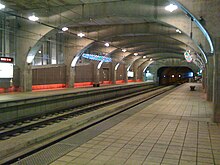

The St. Louis metro area is served by MetroLink (known as Metro) and is the 11th-largest light rail system in the country with 46 mi (74 km) of double track light rail. The Red Line and The Blue Line both serve all the stations in the inner city, and branch to different destinations beyond in the suburban areas. Both lines enter the city north of Forest Park on the western edge of the city or on the Eads Bridge in downtown St. Louis to Illinois. All of the system track is in independent right of way, with both surface level and underground subway track in the city. All stations are independent entry, while all platforms are flush-level with trains. Rail service is provided by the Bi-State Development Agency (also known as Metro), which is funded by a sales taxes levied in the city and other counties in the region.[151] The Gateway Multimodal Transportation Center acts as the hub station in the city of St. Louis, linking the city's light rail system, local bus system, passenger rail service, and national bus service. It is located just east of the historic grand St. Louis Union Station.
Airports

St. Louis is served by two passenger airports. St. Louis Lambert International Airport, owned and operated by the City of St. Louis, is 11 miles northwest of downtown along highway I-70 between I-170 and I-270 in St. Louis County. It is the largest and busiest airport in the state. In 2016, when the airport had more than 255 daily departures to about 90 domestic and international locations, it served more than 15 million passengers.[152] The airport serves as a focus hub city for Southwest Airlines; it was once a hub for Trans World Airlines and a focus-city for American Airlines and AmericanConnection.[152] The airport has two terminals with a total of five concourses. International flights and passengers use Terminal 2, whose lower level holds the Immigration and Customs gates. Passengers can move between the terminals on complimentary buses that run continuously, or via MetroLink for a fee. It was possible to walk between the terminals until Concourse D was closed in 2008.[153]
MidAmerica St. Louis Airport is the secondary passenger airport serving the metropolitan area. Located 17 miles east of the city downtown core, the airport serves domestic passengers. Air cargo transportation is available at Lambert International and at other nearby regional airports, including MidAmerica St. Louis Airport, Spirit of St. Louis Airport, and St. Louis Downtown Airport.
Port authority
River transportation is available through the Port of St. Louis, which is 19.3 miles of riverbank on the Mississippi River that handles more than 32 million tons of freight annually. The Port is the second largest inland port by trip-ton miles, and the third largest by tonnage in the United States, with more than 100 docks for barges and 16 public terminals on the river.[154] The Port Authority added two new small fire and rescue craft in 2012 and 2013.
Railroad service

Inter-city rail passenger train service in the city is provided by Amtrak at the Gateway Multimodal Transportation Center downtown. Amtrak trains terminating in the city include the Lincoln Service to Chicago and the Missouri River Runner to Kansas City, Missouri. St. Louis is an intermediate stop on the Texas Eagle route which provides long-distance passenger service between Chicago, San Antonio, and three days a week, to Los Angeles.[155]
St. Louis is the nation's third largest freight rail hub, moving Missouri exports such as fertilizer, gravel, crushed stone, prepared foodstuffs, fats, oils, nonmetallic mineral products, grain, alcohol, tobacco products, automobiles, and automobile parts.[156] Freight rail service in St. Louis is provided on tracks owned by Union Pacific Railroad, Norfolk Southern Railway, Foster Townsend Rail Logistics – formerly Manufacturers Railway (St. Louis), Terminal Railroad Association of St. Louis, Affton Trucking,[157] and the BNSF Railway.
The Terminal Railroad Association of St. Louis (reporting mark: TRRA) is a switching and terminal railroad jointly owned by all the major rail carriers in St. Louis. The company operates 30 diesel-electric locomotives to move railcars around the classification yards, deliver railcars to local industries, and ready trains for departure.[158] The TRRA processes and dispatches a significant portion of railroad traffic moving through the city and owns and operates a network of rail bridges and tunnels including the MacArthur Bridge (St. Louis) and the Merchants Bridge.[159] This infrastructure is also used by inter-city rail and long-distance passenger trains serving St. Louis.
Bus service

Local bus service in the city of St. Louis is provided by the Bi-State Development Agency via MetroBus, with more than 75 routes connecting to MetroLink light rail transit and stops in the city and region. The city is also served by Madison County Transit, which connects downtown St. Louis to Madison County, Illinois. National bus service in the city is offered by Greyhound Lines, Burlington Trailways and Amtrak Thruway, with a station at the Gateway Transportation Center, and Megabus, with a stop at St. Louis Union Station.
Taxi
Taxicab service in the city is provided by private companies regulated by the Metropolitan Taxicab Commission. Rates vary by vehicle type, size, passengers and distance, and by regulation all taxicab fares must be calculated using a taximeter and be payable in cash or credit card.[160] Solicitation by a driver is prohibited, although a taxicab may be hailed on the street or at a stand.
Notable people
Sister cities
St. Louis has 16 sister cities.[161]
 Bologna, Italy
Bologna, Italy Bogor, Indonesia
Bogor, Indonesia Brčko, Brčko District, Bosnia and Herzegovina
Brčko, Brčko District, Bosnia and Herzegovina Donegal, County Donegal, Ireland
Donegal, County Donegal, Ireland Galway, County Galway, Ireland
Galway, County Galway, Ireland Georgetown, Guyana
Georgetown, Guyana Lyon, France
Lyon, France Nanjing, China
Nanjing, China Rosario, Santa Fe, Argentina
Rosario, Santa Fe, Argentina Saint-Louis, Senegal
Saint-Louis, Senegal Samara, Russia
Samara, Russia San Luis Potosí, Mexico
San Luis Potosí, Mexico Stuttgart, Germany[162]
Stuttgart, Germany[162] Suwa, Japan
Suwa, Japan Szczecin, Poland[163]
Szczecin, Poland[163] Wuhan, China
Wuhan, China
See also
- Caves of St. Louis
- Cuisine of St. Louis
- Delmar Divide
- Downtown St. Louis
- Great Flood of 1993
- Heat wave of 2006 derecho series
- History of the Jews in St. Louis
- LaClede Town
- LGBT culture in St. Louis
- List of mayors of St. Louis
- List of tallest buildings in St. Louis
- National Register of Historic Places listings in St. Louis (city, A–L), Missouri
- National Register of Historic Places listings in St. Louis (city, M-Z), Missouri
- Neighborhoods of St. Louis
- Roman Catholic Archdiocese of St. Louis
- St. Louis Fire of 1849
- St. Louis in the Civil War
- 1939 St. Louis smog
- List of Veiled Prophet Parade themes
- USS St. Louis, 7 ships
Notes
- ^ Mean monthly maxima and minima (i.e. the highest and lowest temperature readings during an entire month or year) calculated based on data at said location from 1991 to 2020.
- ^ Official records for St. Louis were kept at the Weather Bureau Office from January 1874 to December 1892, Eads Bridge from January 1893 to December 1929, and at Lambert–St. Louis Int'l since January 1930.[55]
References
- ^ a b "St. Louis United States – Visiting the Gateway to the West". Globosapiens.net. Archived from the original on May 15, 2011. Retrieved March 14, 2011.
- ^ St. Louis Public Library on "Mound City" Archived October 1, 2008, at the Wayback Machine.
- ^ STLtoday.com on "The Lou".
- ^ "Rome of the West". Stltoday.com. Archived from the original on August 10, 2017. Retrieved August 10, 2017.
- ^ "ArcGIS REST Services Directory". United States Census Bureau. Archived from the original on January 19, 2022. Retrieved August 28, 2022.
- ^ "St. Louis City, Missouri – Population Finder – American FactFinder". United States Geological Survey. October 24, 1980. Archived from the original on January 22, 2020. Retrieved December 23, 2008.
- ^ "Elevations and Distances in the United States". U.S. Geological Survey. U.S. Department of the Interior — U.S. Geological Survey. April 29, 2005. Archived from the original on November 9, 2013. Retrieved October 17, 2016.
- ^ a b c "Explore Census Data". United States Census Bureau. Archived from the original on June 2, 2023. Retrieved October 7, 2022.
- ^ a b "City and Town Population Totals: 2020-2021". United States Census Bureau. September 20, 2022. Archived from the original on July 11, 2022. Retrieved October 7, 2022.
- ^ "Total Gross Domestic Product for St. Louis, MO-IL (MSA)". fred.stlouisfed.org. Archived from the original on October 9, 2023. Retrieved December 7, 2023.
- ^ "Dictionary and Thesaurus - Merriam-Webster". Archived from the original on October 22, 2020. Retrieved July 23, 2020.
- ^ "Metropolitan and Micropolitan Statistical Areas Population Totals: 2020-2022". Census.gov. Archived from the original on June 29, 2022. Retrieved October 27, 2023.
- ^ a b Cazorla, Frank; Baena, Rose; Polo, David; and Reder Gadow, Marion. (2019) The governor Louis de Unzaga (1717–1793) Pioneer in the Birth of the United States of America. Foundation, Malaga, pages 49, 57–65, 70–75, 150, 207
- ^ History: Physical Growth of the City of St. Louis. St. Louis City Planning Commission. 1969.
- ^ "A Brief History of St. Louis". stlouis-mo.gov. Archived from the original on July 26, 2023. Retrieved December 10, 2023.
- ^ a b U.S. Bureau of Economic Analysis (January 1, 2001). "Total Gross Domestic Product for St. Louis, MO-IL (MSA)". FRED, Federal Reserve Bank of St. Louis. Archived from the original on October 9, 2023. Retrieved December 7, 2023.
- ^ "GaWC - The World According to GaWC 2020". www.lboro.ac.uk. Archived from the original on March 16, 2023. Retrieved December 7, 2023.
- ^ "Commerce and Industry | UMSL". www.umsl.edu. Archived from the original on December 8, 2023. Retrieved December 8, 2023.
- ^ "Seven St. Louis-area companies make Fortune 500 list - St. Louis Business Journal". www.bizjournals.com. Archived from the original on January 20, 2024. Retrieved December 7, 2023.
- ^ "St. Louis Zoo named 'Best Zoo' and wins 'Best Zoo Exhibit' in Readers' Choice Awards". FOX2now.com. May 4, 2018. Archived from the original on August 2, 2019. Retrieved August 2, 2019.
- ^ "Missouri Botanical Garden". www.missouribotanicalgarden.org. Archived from the original on August 2, 2019. Retrieved August 2, 2019.
- ^ "Bellefontaine Cemetery and Arboretum Level II Accreditation Listing". arbnet.org/morton-register/bellefontaine-cemetery-and-arboretum. Archived from the original on November 25, 2020. Retrieved December 8, 2021.
- ^ Hoffhaus. (1984). Chez Les Canses: Three Centuries at Kawsmouth, Kansas City: Lowell Press. ISBN 0-913504-91-2.
- ^ Pacte de Famille#The third Pacte de Famille
- ^ www.usgennet.org. Attack On St. Louis: May 26, 1780.
- ^ a b Wade, Richard C. (1959). The Urban Frontier: The Rise of Western Cities, 1790–1830 (1996 Illini Books ed.). Cambridge: Harvard University Press. pp. 3–4. ISBN 0-252-06422-4.
- ^ Van Ravenswaay, Charles (1991). St. Louis: An Informal History of the City and Its People, 1764-1865. Missouri History Museum. p. 26. ISBN 9780252019159.
- ^ Cooperman, Jeannette (March 8, 2019). "St. Louis' Great Divorce: A complete history of the city and county separation and attempts to get back together". St. Louis Magazine. Archived from the original on April 20, 2021. Retrieved April 8, 2021.
- ^ McCabe, James Dabney; Winslow, Edward Martin (1877). The History of the Great Riots: The Strikes and Riots on the Various Railroads of the United States and in the Mining Regions Together with a Full History of the Molly Maguires. Philadelphia. ISBN 9781430443896. Archived from the original on November 24, 2016.
{{cite book}}: CS1 maint: location missing publisher (link) - ^ Clymer, Floyd. Treasury of Early American Automobiles, 1877–1925 (New York: Bonanza Books, 1950), p. 32.
- ^ Arenson, Adam (2015). The great heart of the republic: St. Louis and the cultural Civil War (1st ed.). Columbia (Mo.): University of Missouri Press. ISBN 978-0-8262-2064-6.
- ^ "1904 Summer Olympics". International Olympic Committee. Archived from the original on August 15, 2008. Retrieved April 20, 2007.
- ^ Primm, James. Lion of the Valley: St. Louis, Missouri, 1764-1980. St. Louis, Missouri: Missouri History Museum Press. 1998. Print
- ^ Smith, Jeffrey. "A Preservation Plan for St. Louis Part I: Historic Contexts" St. Louis, Missouri Cultural Resources Office. Web. Retrieved November 13, 2014.
- ^ NAACP. Papers of the NAACP Part 5. The Campaign against Residential Segregation. Frederick, MD: University Publications of America. 1986. Web
- ^ "Shelley House". We Shall Overcome: Historic Places of the Civil Rights Movement. National Park Service. Retrieved November 10, 2014.
- ^ Early, Gerald Lyn (1998). Ain't But a Place: An Anthology of African American Writings about St. Louis. Missouri History Museum. pp. 307–314. ISBN 978-1-883982-28-7.
- ^ Hemmings, American City Business Journals, accessed January 22, 2022 [1] Archived January 24, 2022, at the Wayback Machine
- ^ O'Neil, Tim (November 28, 2016). "Nov. 28 1939: The day 'Black Tuesday' rolled into St. Louis". St. Louis Post-Dispatch. Archived from the original on December 2, 2016. Retrieved December 8, 2016.
- ^ "St. Louis: Desegregation and School Choice in the Land of Dred Scott" (PDF). Archived from the original (PDF) on June 21, 2004. Retrieved October 1, 2010.
- ^ "Physical Growth of the City of St. Louis". Archived from the original on July 26, 2010. Retrieved July 27, 2010.
- ^ "Washington Avenue is Named "Great Street" by American Planning Association". stlouis-mo.gov. October 4, 2011. Archived from the original on January 14, 2024. Retrieved November 29, 2023.
- ^ Kukuljan, Steph (March 21, 2022). "Cortex, facing unprecedented challenges, plots new course. 'This is an evolution,' says chief". STLtoday.com. Archived from the original on November 15, 2023. Retrieved November 15, 2023.
- ^ Bean, Randy. "Meet Me In St. Louis – The Reemergence Of An Innovation Hub". Forbes. Archived from the original on November 15, 2023. Retrieved November 15, 2023.
- ^ Moore, Doug (April 29, 2018). "These longtime St. Louis residents are digging in as their neighborhood takes off". STLtoday.com. Archived from the original on January 20, 2024. Retrieved November 29, 2023.
- ^ "Forest Park South East Census Data | City of St. Louis". stlouis-mo.gov. Archived from the original on May 18, 2022. Retrieved November 29, 2023.
- ^ "Rams owner Kroenke rips St. Louis market as he seeks LA move". AP News. January 6, 2016. Archived from the original on May 24, 2023. Retrieved November 29, 2023.
- ^ "$790M settlement in lawsuit over Rams' St. Louis departure". AP News. November 24, 2021. Archived from the original on November 24, 2023. Retrieved November 29, 2023.
- ^ Lohraff, Kevin (2009). Hiking Missouri (2nd ed.). Champaign, IL: Human Kinetics. p. 73. ISBN 978-0-7360-7588-6. Archived from the original on January 2, 2017. Retrieved November 1, 2016.
- ^ a b c d e f Saldivar, Marcos. "26 Reasons St. Louis Is America's Hidden Gem". Huffington Post. Archived from the original on March 24, 2014. Retrieved March 24, 2014.
- ^ Neighborhoods of the City of St. Louis Archived May 12, 2012, at the Wayback Machine, StLouis-mo.gov
- ^ "2010 Census Gazetteer Files". United States Census Bureau. August 22, 2012. Archived from the original on October 21, 2013. Retrieved November 20, 2014.
- ^ St. Louis – News – A Sewer Runs Through It Archived March 11, 2007, at the Wayback Machine.
- ^ "Historical Weather for St. Louis, Missouri". Archived from the original on September 16, 2012. Retrieved October 15, 2009.
- ^ ThreadEx
- ^ "Station Name: MO ST LOUIS LAMBERT INTL AP". U.S. Climate Normals 2020: U.S. Monthly Climate Normals (1991–2020). National Oceanic and Atmospheric Administration. Retrieved July 22, 2021.
- ^ "NowData – NOAA Online Weather Data". National Oceanic and Atmospheric Administration. Retrieved July 22, 2021.
- ^ "WMO Climate Normals for ST. LOUIS/LAMBERT, MO 1961–1990". National Oceanic and Atmospheric Administration. Retrieved July 22, 2021.
- ^ "Historical UV Index Data - St. Louis, MO". UV Index Today. Retrieved April 22, 2023.
- ^ "Warmer weather attracting Armadillos" Archived October 30, 2013, at archive.today, accessed October 28, 2013
- ^ "Census of Population and Housing". Census.gov. Archived from the original on May 7, 2015. Retrieved June 4, 2016.
- ^ "A Brief History of St. Louis". Archived from the original on July 26, 2023. Retrieved July 26, 2023.
- ^ a b c d "Race and Hispanic Origin for Selected Cities and Other Places: Earliest Census to 1990". U.S. Census Bureau. Archived from the original on August 12, 2012. Retrieved April 21, 2012.
- ^ Gibson, Campbell (June 1998). "Population of the 100 largest cities and other urban places in the United States: 1790 to 1990". U.S. Census Bureau. Archived from the original on March 14, 2007. Retrieved December 12, 2007.
- ^ "Census". Dynamic.stlouis-mo.gov. Archived from the original on July 24, 2017. Retrieved August 10, 2017.
- ^ "U.S. Census website". United States Census. Archived from the original on December 27, 1996. Retrieved October 5, 2018.
- ^ "Race and Hispanic or Latino Origin: 2010". United States Census. Retrieved October 8, 2013.[permanent dead link]
- ^ Druart, T. (February 2010). "Convio ranks most generous online cities". convio. Archived from the original on September 27, 2011. Retrieved August 21, 2011.
- ^ "St. Louis (city) County, Missouri". Modern Language Association. Archived from the original on August 15, 2013. Retrieved August 10, 2013.
- ^ "2020 Census Results". U.S. Census Bureau. Archived from the original on November 23, 2021. Retrieved November 23, 2021.
- ^ "St. Louis (city), Missouri". State & County QuickFacts. U.S. Census Bureau. Archived from the original on December 3, 2012.
- ^ "2000 Census Summary". City of St. Louis. Archived from the original on April 3, 2015. Retrieved March 9, 2015.
- ^ "MCDC Demographic Profile". Mcdc.missouri.edu. Archived from the original on March 5, 2017. Retrieved August 10, 2017.
- ^ a b From 15% sample
- ^ Ellis, Stefanie (January 17, 2022). "St Louis: The US city transformed by heartbreak". BBC. Archived from the original on February 5, 2022. Retrieved February 4, 2022.
- ^ "The Bosnian Community in St. Louis by Imam Muhamed Hasic". Stlbosnians.com. Archived from the original on September 12, 2018. Retrieved August 10, 2017.
- ^ Gilsinan, Kathy. "Why Are There So Many Bosnians in St. Louis?". The Atlantic Cities. Atlantic Media Company. Archived from the original on February 17, 2013. Retrieved February 15, 2013.
- ^ "ABOUT US". bhacc. Archived from the original on July 1, 2023. Retrieved July 2, 2023.
- ^ "Millennials really like St Louis". The Economist. April 12, 2017. Archived from the original on April 13, 2017. Retrieved April 14, 2017.
- ^ a b "Crime in the United States, 2015". FBI.gov (Uniform Crime Reports). Archived from the original on March 22, 2017. Retrieved April 5, 2017.
- ^ Bosman, Julie and Mitch Smith (December 28, 2016). Article comparing Chicago's annual homicide statistics to those of other American cities, including St. Louis, New York Times. Archived March 31, 2017, at the Wayback Machine
- ^ "NeighborhoodScout's Most Dangerous Cities - 2020". NeighborhoodScout. January 2, 2020. Archived from the original on March 8, 2017. Retrieved June 8, 2020.
- ^ "Methodology". Morganquitno.com. Archived from the original on May 11, 2011. Retrieved March 14, 2011.
- ^ "2015". Ucr.fbi.gov. Archived from the original on August 30, 2017. Retrieved August 10, 2017.
- ^ "Archived copy" (PDF). Archived from the original (PDF) on October 19, 2016. Retrieved October 18, 2016.
{{cite web}}: CS1 maint: archived copy as title (link) - ^ Murphy, Doyle (January 3, 2017). "St. Louis Murder Toll Hit 188 in 2016--Tying 2015's Unusually High Number." Archived January 16, 2017, at the Wayback Machine Riverfront Times (RFT). Retrieved January 15, 2017.
- ^ a b "Focused police presence in north St. Louis, better relationships with protesters among new chief's goals". St. Louis Post-Dispatch. January 3, 2018. Archived from the original on February 6, 2018. Retrieved January 30, 2018.
- ^ St. Louis Crime tracker-City snapshot, https://graphics.stltoday.com/apps/crime/index.html Archived December 11, 2017, at the Wayback Machine Retrieved January 30, 2018
- ^ Asher, Jeff (December 17, 2019). "South Bend and St. Louis, Where Crime Statistics Can Mislead". The New York Times. Archived from the original on September 13, 2020. Retrieved July 14, 2020.
- ^ U.S. Bureau of Economic Analysis (January 1, 2001). "Total Gross Domestic Product for St. Louis, MO-IL (MSA)". FRED, Federal Reserve Bank of St. Louis. Retrieved February 6, 2024.
- ^ U.S. Census Bureau (January 1, 1969). "Resident Population in St Louis, MO-IL (MSA)". FRED, Federal Reserve Bank of St. Louis. Retrieved February 6, 2024.
- ^ 2007 Economic Census.
- ^ Schneider, Joey (May 26, 2022). "Seven St. Louis-area companies named in 2022 Fortune 500 list". FOX 2. Archived from the original on November 1, 2022. Retrieved November 1, 2022.
- ^ "Missouri Pacific Railroad". Up.com. Archived from the original on August 17, 2017. Retrieved August 10, 2017.
- ^ Stoller, Gary (March 24, 2003). "JDAM smart bombs prove to be accurate and a good buy". USA Today. Archived from the original on March 25, 2011. Retrieved March 14, 2011.
- ^ "Ratings and Rankings – Area Companies". Stlrcga.org. Archived from the original on November 29, 2010. Retrieved March 14, 2011.
- ^ "About Us | The Federal Reserve Bank of St. Louis". St. Louis Fed. Archived from the original on December 19, 2010. Retrieved March 14, 2011.
- ^ Kirn, Jacob; Acieri, Katie (April 30, 2014). "Triad bound? Heritage Home moving HQ to North Carolina". Triad Business Journal. Archived from the original on May 31, 2014. Retrieved May 30, 2014.
- ^ Arcieri, Katie (May 19, 2015). "Heritage Home Group names interim CEO". Triad Business Journal. Archived from the original on May 23, 2015. Retrieved December 4, 2015.
- ^ "St. Louis Health Care". RCGA St. Louis. Archived from the original on May 27, 2013. Retrieved May 24, 2013.
- ^ "Siteman Cancer Center, About Us". Siteman Cancer Center. Archived from the original on May 12, 2013. Retrieved May 24, 2013.
- ^ "Ratings and Rankings". RCGA St. Louis. Archived from the original on January 6, 2007. Retrieved May 24, 2013.
- ^ Home – The Genome Institute at Washington University Archived October 19, 2019, at the Wayback Machine. Genome.wustl.edu. Retrieved on August 16, 2013.
- ^ Wagner, Julie (May 5, 2016). "In St. Louis, a gateway to innovation and inclusion". Brookings. Archived from the original on September 19, 2018. Retrieved September 18, 2018.
- ^ "Cortex Official Website". Archived from the original on April 11, 2019. Retrieved September 18, 2018.
- ^ "Boeing to shed 1,500 IT jobs here over next three years". The Seattle Times. May 10, 2013. Archived from the original on May 13, 2013. Retrieved May 13, 2013.
- ^ "Boeing's shift to St. Louis reflects broader shifts in local economy". St. Louis Post-Dispatch. May 13, 2013. Archived from the original on January 5, 2018. Retrieved October 8, 2013.
- ^ "Launch Code: How 42 "Unqualified" People Landed Dream Tech Jobs in St. Louis". Blogs.riverfronttimes.com. Archived from the original on June 13, 2015. Retrieved August 10, 2017.
- ^ Empson, Rip (February 21, 2012). "Arch Grants Raises $2.5M To Turn St. Louis Into A Startup Hub; Square Co-founder Signs On". Social.techcrunch.com. Archived from the original on July 9, 2017. Retrieved August 10, 2017.
- ^ Simpson, Maddy (August 31, 2022). "St. Louis' largest employers". www.bizjournals.com. Archived from the original on April 14, 2022. Retrieved February 26, 2023.
- ^ "FY 2023 Annual Comprehensive Financial Report (ACFR)". February 13, 2023. Archived from the original on August 27, 2023. Retrieved August 26, 2023.
- ^ "Old Strassberger Music Conservatory". stlouis-mo.gov. Archived from the original on September 1, 2023. Retrieved September 1, 2023.
- ^ "Strassberger's Conservatory" (PDF). Archived (PDF) from the original on September 1, 2023. Retrieved September 1, 2023.
- ^ "Alfonso D'Artega", Wikipedia, August 28, 2023, archived from the original on January 20, 2024, retrieved September 1, 2023
- ^ "Charity Navigator - 2015 Metro Market Study". Charitynavigator.org. Archived from the original on August 29, 2017. Retrieved August 10, 2017.
- ^ "25 Things to Do in St. Louis". Archived from the original on February 13, 2012. Retrieved February 17, 2012.
- ^ The station was sold by the Lutheran Church–Missouri Synod for $18 million, funded in part through a donation by then-St. Louis Cardinals star Albert Pujols, and converted to contemporary Christian music.Deidre Pujols sounds off on Christian radio, STLtoday.com Archived August 22, 2014, at the Wayback Machine, December 12, 2011
- ^ "Washington National Opera lands a star: Timothy O'Leary to become general director - the Washington Post". The Washington Post. Archived from the original on October 22, 2018. Retrieved October 21, 2018.
- ^ "Imo's Pizza - The Square Beyond Compare". Imospizza.com. Archived from the original on August 25, 2017. Retrieved August 10, 2017.
- ^ "Ted Drewes Frozen Custard - Home". Archived from the original on February 8, 2014. Retrieved March 4, 2014.
- ^ "St Louis Cardinals Franchise Timeline". St Louis Cardinals. Archived from the original on March 2, 2022. Retrieved March 1, 2022.
- ^ "St Louis Cardinals Postseason results". St Louis Cardinals. Archived from the original on March 2, 2022. Retrieved March 1, 2022.
- ^ Tim Bryant, "Citygarden an immediate hit with visitors." St. Louis Post-Dispatch. July 1, 2009.
- ^ David Bonetti, "Spectacular Citygarden is opening on schedule in St. Louis Archived July 1, 2009, at the Wayback Machine", St. Louis Post-Dispatch, June 28, 2009.
- ^ [2] Archived June 23, 2011, at the Wayback Machine
- ^ "Counties and Equivalent Entities of the United States, Its Possessions, and Associated Areas; Change Notice No. 7". 2001. Archived from the original on September 29, 2013. Retrieved May 27, 2006.
- ^ "City of St. Louis Elected Officials". Stlouis-mo.gov. July 8, 2010. Archived from the original on April 6, 2012. Retrieved March 24, 2012.
- ^ Guide to the Board of Aldermen Archived October 28, 2013, at the Wayback Machine, StLouis-mo.gov
- ^ "City's budget tops $1 billion for first time". Business Journal. July 1, 2014. Archived from the original on July 14, 2014. Retrieved July 1, 2014.
- ^ "SoS, Missouri – Elections: Registered Voters in Missouri 2012". Sos.mo.gov. Archived from the original on October 25, 2012. Retrieved November 10, 2012.
- ^ "SoS, Missouri – Elections: Registered Voters in Missouri 2008". Sos.mo.gov. Archived from the original on November 16, 2011. Retrieved April 1, 2012.
- ^ "City of St. Louis Departments". Stlouis-mo.gov. Archived from the original on August 11, 2017. Retrieved August 10, 2017.
- ^ "Wards and Aldermen". Archived from the original on October 26, 2022. Retrieved October 26, 2022.
- ^ "First Time All 28 Aldermen Are Democrats – UrbanReview - ST LOUIS". webcache.googleusercontent.com. Archived from the original on June 16, 2019. Retrieved December 5, 2019.
- ^ "Public Safety: Annual Operating Plan" (PDF). Board of Aldermen. June 29, 2019. p. 3. Archived (PDF) from the original on November 13, 2022. Retrieved June 29, 2019.
- ^ S, Nicole; ers (May 24, 2022). "New certification to allow St. Louis City deputies to make arrests, traffic stops". KMOV. Archived from the original on November 13, 2022. Retrieved November 13, 2022.
- ^ Leip, David. "Dave Leip's Atlas of U.S. Presidential Elections". uselectionatlas.org. Archived from the original on March 23, 2018. Retrieved October 25, 2022.
- ^ "Statewide House Map" (PDF). Missouri Secretary of State. January 21, 2022. Archived (PDF) from the original on August 10, 2023. Retrieved August 9, 2023.
- ^ "Statewide Senate Map" (PDF). Missouri Secretary of State. March 15, 2022. Archived (PDF) from the original on March 7, 2023. Retrieved August 9, 2023.
- ^ Cite error: The named reference
districtmapswas invoked but never defined (see the help page). - ^ "Who We Are". National Geospatial-Intelligence Agency. August 4, 2008. Archived from the original on February 26, 2009. Retrieved January 22, 2010.
- ^ "Veterans' Service Records". Archives.gov. August 15, 2016. Archived from the original on July 29, 2017. Retrieved August 10, 2017.
- ^ "Overview of Washington University in St. Louis". U.S. News & World Report. Archived from the original on July 4, 2019. Retrieved December 19, 2019.
- ^ "2020 census - school district reference map: St. Louis city, MO" (PDF). U.S. Census Bureau. Archived (PDF) from the original on July 22, 2022. Retrieved July 22, 2022. - Text list Archived July 22, 2022, at the Wayback Machine
- ^ "Slps.org". Slps.org. Archived from the original on May 1, 2009. Retrieved March 14, 2011.
- ^ "Private Catholic School - Chesterfield - History". Sluh.org. Archived from the original on January 18, 2017. Retrieved January 15, 2017.
- ^ "Nielsen Media 2010–2011 Local Market Estimates". Nielsen Media Research. Broadcast Employment Services. October 1, 2010. Archived from the original on August 28, 2008. Retrieved July 20, 2011.
- ^ Arbitron (June 2011).
- ^ [3] Archived July 20, 2013, at the Wayback Machine
- ^ Tucker, Justin. "Top 10 Films Set (or Partially Set) in St. Louis". Inside St. Louis. Archived from the original on May 8, 2016. Retrieved April 25, 2016.
- ^ "Metro – Inside MetroLink". Metro. Archived from the original on September 11, 2008. Retrieved October 29, 2008.
- ^ a b "Lambert – St. Louis International Airport > Home - View_Blog". Flystl.com. Archived from the original on August 11, 2017. Retrieved August 10, 2017.
- ^ "St. Louis Airport Reopens, One Concourse Remains Closed". Travelpulse.com. April 25, 2011. Archived from the original on March 24, 2012. Retrieved November 22, 2011.
- ^ "St. Louis Port Authority". Stlouis-mo.gov. April 16, 2013. Archived from the original on February 21, 2014. Retrieved February 7, 2014.
- ^ amtrak.com
- ^ Brite, Tony. "Rail Freight" (PDF). Missouri Economic Research and Information Center. Archived from the original (PDF) on June 29, 2014. Retrieved January 28, 2014.
- ^ "Affton Trucking". Afftontrucking.com. Archived from the original on August 2, 2017. Retrieved August 10, 2017.
- ^ "TRRA History". Terminalrailroad.com. Archived from the original on February 2, 2014. Retrieved February 7, 2014.
- ^ "TRRA Home". Terminalrailroad.com. Archived from the original on February 1, 2014. Retrieved February 7, 2014.
- ^ "Archived copy" (PDF). Archived from the original (PDF) on March 27, 2012. Retrieved July 17, 2011.
{{cite web}}: CS1 maint: archived copy as title (link) - ^ "St. Louis Sister Cities". St. Louis Center for International Relations. Archived from the original on December 17, 2021. Retrieved March 24, 2022.
- ^ "Stuttgart Städtepartnerschaften". Landeshauptstadt Stuttgart, Abteilung Außenbeziehungen (in German). Archived from the original on August 8, 2013. Retrieved July 27, 2013.
- ^ "Kontakty partnerskie Miasta Szczecin". Urząd Miasta Szczecin (in Polish). Archived from the original on August 18, 2012. Retrieved July 29, 2013.
Further reading
- Berger, Henry W. St. Louis and Empire: 250 Years of Imperial Quest and Urban Crisis. Carbondale, IL: Southern Illinois University Press, 2015.
- Ekberg, Carl J., and Sharon K. Person, St. Louis Rising: The French Regime of Louis St. Ange de Bellerive. Urbana, IL: University of Illinois Press, 2015.
- Gordon, Colin. Mapping Decline: St. Louis and the Fate of the American City. Philadelphia: University of Pennsylvania Press, 2008. ISBN 9780812220940
- Primm, James Neal. Lion of the Valley: St. Louis, Missouri, 1764-1980 (1998) a major scholarly history online
External links
- Official website
- St. Louis Regional Chamber and Growth Association
- Historic maps of St. Louis in the Sanborn Maps of Missouri Collection at the University of Missouri


